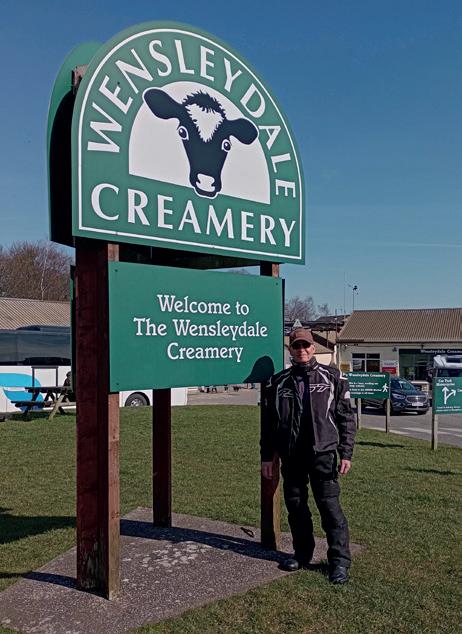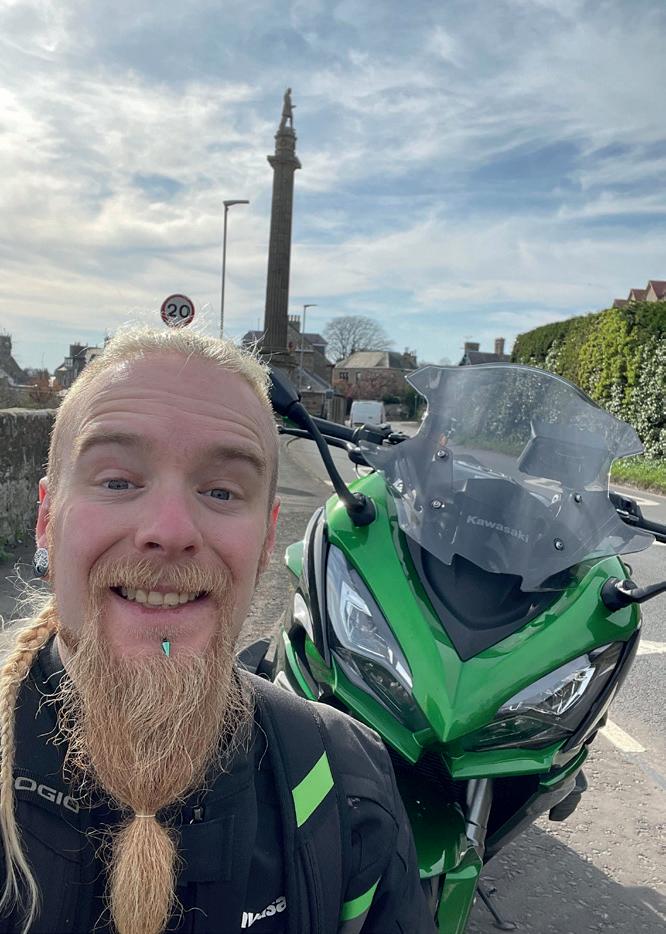










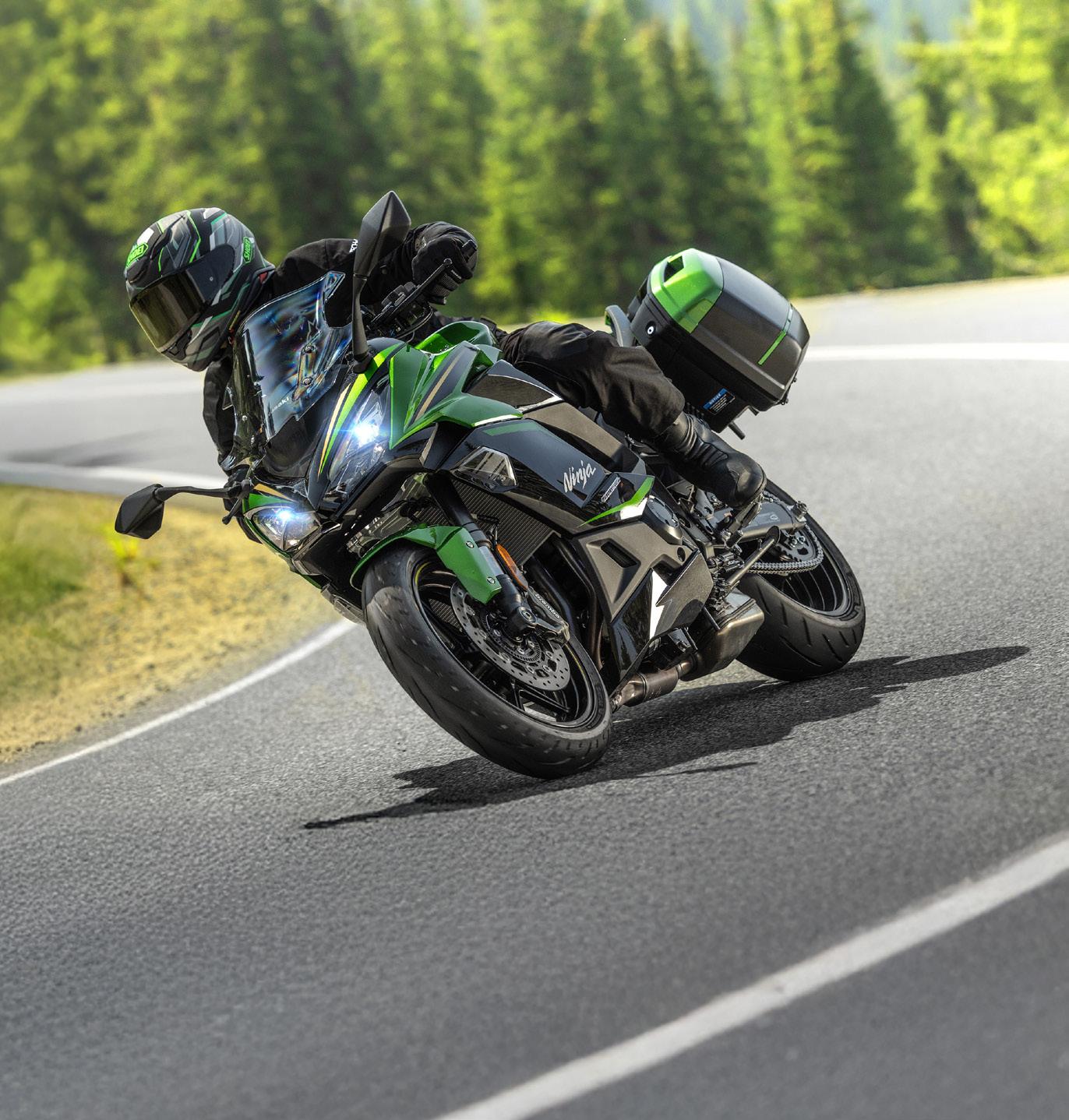


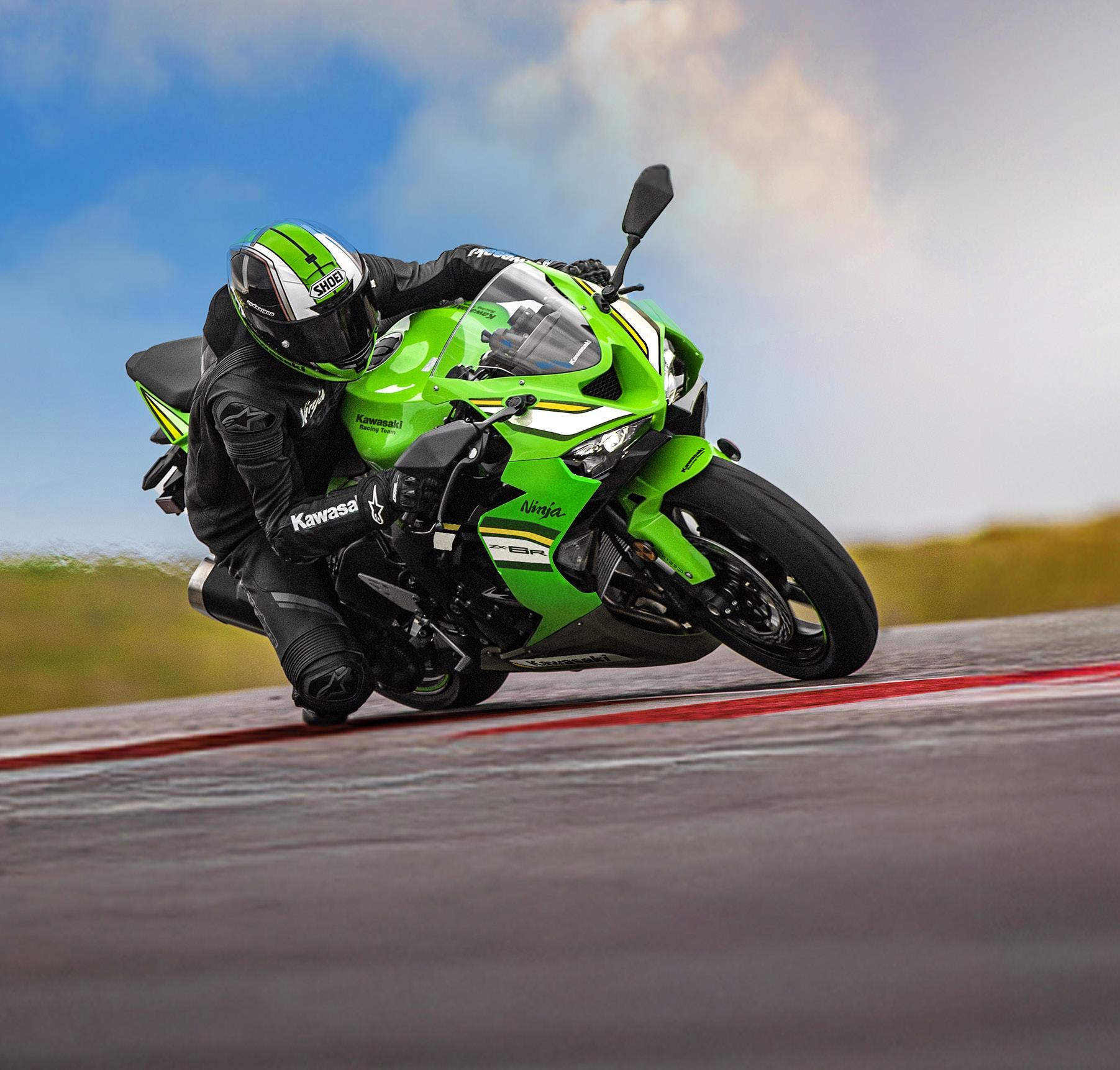


















Welcome to Club Magazine – issue 29!
Hi everyone. In this issue, we’ve packed in everything you need to fuel your two-wheeled obsession, from big news and fresh concepts to epic rides and insider scoops.
We kick things off with the latest news from the past six months — what’s hot, what’s next and what you might have missed while your bike was tucked away in the garage. Speaking of garages, Out of Hibernation: Part 2 is our essential guide to waking up your bike the right way and getting prepped for prime riding time.
Feeling the itch for open roads? What a Ride! brings you tales from fellow riders on the routes that stole their hearts, while Tours by Simon Weir will inspire your next adventure and also comes with an exclusive Club

discount you won’t want to miss.
We go further under the visor in Behind the Scenes of an EPI (European Press Introduction), which shows you what really happens on set. We also explore the roots of iconic Italian engineering in bimota: The Kawasaki Connection. Plus, a look into the future with the stunning new Corleo concept.
If you like your thrills sideways, don’t miss our Flat Track feature, and for those who chase horizons, Adventure is Out There maps out unforgettable national park rides with advice on being a road-respectful explorer.
I hope you enjoy issue 29 of the Club magazine; we will be back with issue 30 in November.
Enjoy!

Charlotte Stow | Editor
CLUB KAWASAKI MAGAZINE IS BROUGHT TO YOU BY
Editor: Charlotte Stow
Designer: Kar Lee
Exclusive content: Martin Lambert, Ross Burridge, Simon Weir
Contributors: Mike Aylwin, Dialogue Content Marketing Ltd
Thanks to: Carl Lillywhite, Jemma Newman
Photography: KME, KMUK, Tim KeetonImpact Images
Published by Kawasaki Motors UK www.kawasaki.co.uk
Printed by Dialogue Content Marketing Ltd
Membership www.club-kawasaki.co.uk


©2025 Kawasaki Motors UK. All rights reserved. No part of this magazine may be used or reproduced without the written permission of the publisher. All information contained within this magazine is for information only and is, as far as we are aware, correct at the time of going to press. Kawasaki Motors UK cannot accept any responsibility for errors or inaccuracies in such information.





10 OUT OF HIBERNATION
Part 2 of our hibernation series brings you our top tips on how to prepare for the riding season if your bike has been stored away for the winter.
Five Club members tell us about their favourite rides. Ranging from Devon, all the way to the Scottish Highlands.
We interviewed Gianluca Galasso, bimota’s Marketing Manager, to give you an insight into this small yet world-famous Italian company.
Kawasaki unveiled the future sensory off-road mobility “CORLEO” concept model at the EXPO 2025 in Osaka, Japan.
30
We take you behind the scenes of our Z900 product launch in sunny Benidorm.
Improve your riding and slide! The Champions Flat Track School can show you how in the most thrilling way.

42 ROUTE MASTER STICKS WITH KAWASAKI
Simon Weir is a motorcycle touring expert and author of several books on biking destinations. Find out how he got on with our Ninja 1100SX SE Tourer.
We have identified some motorcyclefriendly national parks for you to enjoy.
52
Meet the staff member responsible for creating and managing our technical training sessions.
5 NEWS

From the KB4 to the KB998 Rimini and the supercharged Tera, there’s a
Any of our Club Kawasaki members who joined us in the capital back in February would have been some of the first motorcyclists in the UK to see the all-new bimota range.
We used the MCN London Motorcycle Show to officially launch the brand and
It has been a positive start to 2025 for our extensive Kawasaki dealer network, as we welcome five new locations across the UK.
Riders on the Channel Islands can now visit The Mansell Collection in St Helier, Jersey, which now stocks the latest 2025 models.
We’re also excited to welcome Duques Garage Ltd in Guernsey. For riders in Essex and East London, Kawasaki Chelmsford opened their doors in early January, while Bill Smith Motors in Chester and The Motorbike Shop in Farnborough ensure Kawasaki fans are never far from a dealer.
It has been a busy winter in the world of Kawasaki, with lots of news and exciting opportunities. If you have been following our social media channels, then you will likely have seen most of it, but if not (or you just want a quick recap), here are some of the key stories you might have missed… and supercharged H2 SX SE and Z H2 SE. Visit www.kawasaki.co.uk to learn more and secure your space.
showcase the retro-inspired KB4, the supercharged Tera and the KB998 Rimini, the World Superbike homologation special as raced by Alex Lowes and Axel Bassani.
Since then, we have been working to establish a dealer network throughout the UK, with bikes set to arrive over
the coming months. We are pleased to announce the following dealers so far, bimota by Signature Moto, bimota by Chris Walker Motorcycles, bimota by Cobb & Jagger, bimota by M&P and bimota by Hyside Motorcycles. Make sure you stay tuned to our socials and website for the latest news.

Speaking of our dealers, have you signed up to any of our Dealer Demo Days yet?
Our summer roadshow is back for 2025 and dealers the length and breadth of the country are giving local riders the chance to experience the latest Kawasaki machines, including the all-new Z900, Ninja 1100SX SE and Versys 1100 SE, as well as other popular machines including the range of 500cc machines, Ninja ZX-6R and ZX-10R


Enjoy 0% HP and 5.9% PCP on a wide range of Kawasaki machines!
With the biking season firmly here, there has never been a better time to ride away on a new Kawasaki! With a host of attractive offers across a huge range of bikes, those customers opting for 2024 MY 650cc and under machines will be able to enjoy an incredible 0% APR on HP or 5.9% APR representative on PCP, except for the Ninja ZX-4RR and ZX-6R, which are available on 0% APR on HP and 3.9% APR representative on PCP*.
a free
These rates are available when purchasing through Kawasaki Finance.
Whether it’s the retro-inspired Z650RS, the adventure-calling Versys 650, the exciting Ninja 500 or the entry-level 125 range, this is your chance to kick-start the summer with a new Kawasaki! Visit your local Kawasaki dealer today to learn more. Offer ends 30th June 2025.

Eligible machines include: Z650RS, Z650, Vulcan S, Versys 650, Ninja 650, Ninja 500, Eliminator 50, Z500, Ninja 125, Z125

This summer, Kawasaki is offering all motorcyclists the chance to bag an exclusive free gift from Silkolene, as well as save on the purchase of any of its 500cc models!
Any rider who registers their details with their local Kawasaki dealer between now and 30th June will receive a special Silkolene gift to help them keep their bike road-ready. Not only that, but everyone who registers will also receive a £200 voucher off the purchase price of the 2024 Ninja 500, 2024 Z500 or 2024
Eliminator 500
Scan the QR code right to claim your voucher. While stocks last.

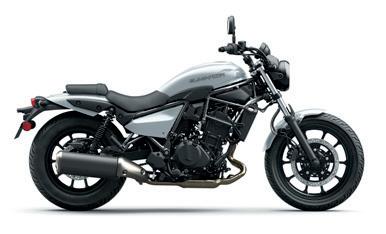

Three great bikes and three great offers on these 2024 models


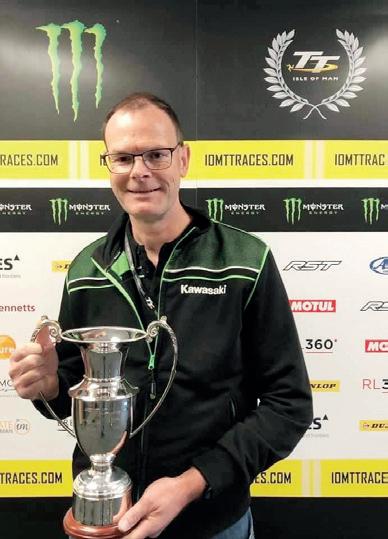

From mechanic to KMUK General Manager, Howard has seen it all


After 45 years of service to Kawasaki, Kawasaki Motors UK, Kawasaki Europe and the head office in Japan, Howard Dale has called time on his role as General Manager.
A true example of someone who worked their way to the top, Howard is a rare beast in today’s business environment. He started as a mechanic then transferred to KMUK (when it was still a limited company) to work in many departments on his way to the “top job”.
His vast skill set, including the ability to work on all manner of vehicles, understand the technical side of a complex model line and immerse himself in product liability law, made him the ideal candidate to eventually be placed in the role of General Manager, a position he held for 22 years.
A youth motocross rider of a high standard, Howard actually cut his teeth off-road riding Suzuki machinery from RM125 all the way up to the mighty RM500; an example of which he is currently restoring.
Working life started at CBS Motorcycles of Whitton, then an advert in MCN placed by Kawasaki allowed Howard to get his “foot in the door” as a Technical Service Advisor, which led to a management role within the same department. As the
tectonic plates of management moved, a chance to “understudy” the then General Manager, Howard Coombes, came in 2002. This turned into a full-time position in 2003, and he made the role his own until spring 2025.
Never an office hermit, Howard lives and breathes Kawasaki and is a keen and accomplished road and off-road rider –woe betide anyone who tags behind him on a track day and thinks they can easily keep up. That ability allowed Howard to also contribute to the development of numerous models over the years, including multiple visits to test tracks and the factory in Akashi, Japan.
Never an office hermit, Howard lives and breathes Kawasaki
Always happy to work the stand at the NEC show, visitors could hear first-hand about bikes, how they handled and the key features from an expert not knowing they were conversing with the head of Kawasaki in the UK.
Not that Howard confined himself to Kawasaki. In his time he contributed greatly to the UK industry as well via
his work within the MCIA (Motorcycle Industry Association) on practical and political levels.
At the helm through good times and bad – including Covid-19 – Howard navigated KMUK through the highs and lows of a business that had two customers – the end user and Kawasaki dealers. Fulfilling the wants and needs of both took special skills and Howard excelled, helped by his loyal and supportive sales and marketing team, headed up by Craig Watson.
In what little spare time he allowed himself, Howard took on the “family hobby” of cycling, following in his father’s wheel tracks to such an extent he now frequently reaches top-10 positions and podiums in highly competitive cycle races.
Father to three girls and sharing family responsibilities with his wife, Sally, Howard has not left Kawasaki entirely as he will consult on some new and exciting projects for Kawasaki Europe, but at a more cycle-friendly three days a week.
Howard handed the reins over to Hiroshi Suzuki at the start of April, leaving a position and presence in the UK industry that many aspire to yet few actually attain. Everyone at KMUK wishes him well and good fortune in his new consultancy role. n
DEALER DEMO DAYS



The incredibly popular Kawasaki Dealer Demo Days are returning this summer, giving riders the chance to experience the latest 2025 models. With dates across the country, this is set to be the biggest Dealer Demo tour yet.
Join us at BSB this year to enjoy fantastic value weekend circuit entry tickets. If you haven’t witnessed the atmosphere first hand, the explosive acceleration off the line or the riders rubbing elbows at incredible speeds – then you really should!



If you've ever wanted to sample a supercharged Kawasaki, grab the opportunity at one of our Dealer Demo Days!

5-7
Join us for the 2025 Southampton International Boat Show at Mayflower Park where we will be displaying not only our Jet Ski® range but also our Mules and ATVs.
OCTOBER
3-5

15-23
Visit the largest motorcycle show in the UK to see the latest 2026 Kawasaki model range revealed. Look out for further details to be released about the Club Kawasaki preview event on the opening Saturday –show ticket included.
The sun has finally made an appearance, so it’s time to open the garage doors and make sure your bike is ready for the summer ahead
Illustrations: Kardesign
The warmer weather has finally arrived here, and so our attention turns to ensuring that the bike stored over the winter is ready for the road again. In the enthusiasm to shake off the winter blues and get out on the road, it’s essential that you don’t neglect a full check on your bike. Here we guide you through the essential procedures to make sure your new riding season is safe and trouble-free.
A battery that has been looked after over winter will serve you well in spring
One of the first things you’ll need to do to is ensure your battery is fully charged and ready to go. During the winter months it is recommended to inspect the battery voltage periodically. For a modern battery, if the voltage reading is below 12.612.8 volts it should be charged. Check the battery terminals are tight and corrosion free. Then connect your battery to a dedicated motorcycle charger. If the battery fails to hold a charge, replace it with a high-quality battery compatible with your Kawasaki model.
Check the brakes are working correctly without sticking. Inspect the brake pads and discs for thickness, scoring or warping, and if in doubt, replace. Check the brake lines for any signs of leakage or cracks at the same time.


Checking
Winter storage can be hard on tyres, especially if your bike was parked without raising the wheels off the floor or parked on concrete instead of wood or carpet. Check the tyres carefully for any signs of degradation, such as wear and tear, bulges, cracks and cuts. Check and adjust tyre pressure to the manufacturer recommendations, and make sure the tread depth meets the legal minimum. Also, check the dot code on the sidewall that shows the tyre’s age. Tyres have a limited lifespan, even if they appear in good condition.
Check all lights, including headlight high and low beam, taillights, brake lights and indicators for correct operation. Test the horn, check the throttle, brake levers, clutch and other controls for smooth operation and correct travel and feel and lubricate as needed. Check and clean or replace the air filter and check all fasteners for tightness.
By following these steps, your motorcycle will be ready for a safe and enjoyable summer of riding!
If you’re in any doubt about your mechanical abilities, or just for peace of mind, it’s worth booking your bike in with your local Kawasaki dealer for a scheduled service – they are the experts! This will also reveal any issues that you might have missed.
Finally, with all checks completed – including checking your riding gear, and that your machine’s road tax, insurance and MOT are current – take your Kawasaki for an initial short, gentle ride and listen out for any unusual noises and feel for irregularities before fully unleashing it on the open road. Since you’ve been away from your bike for a few months, this is also a perfect opportunity for you to reawaken that muscle memory and ease back into the habit of riding once again.
Remember, Club Kawasaki is a valuable resource, so if you have any questions don’t hesitate to ask them on the Club forum, share your experiences and learn from the wisdom and expertise of fellow enthusiasts.
By following these steps, your motorcycle will be ready for a safe and enjoyable summer of riding.
For chain-driven Kawasakis, proper chain and sprocket maintenance is essential. Check the chain for signs of wear, adjust to the correct tightness and clean and lubricate to Kawasaki specification. This is a good time to also check the condition of the sprockets for wear and damage; replace worn chain and sprockets as a set. Owners with a shaft drive need to make sure the fluid doesn’t need topping up or changing.
Fluids degrade over time, even if the bike is stationary. If you changed the fluids before storage, you should be good to go, apart from a quick levels check. If this wasn’t the case, make sure fluids are changed or topped up according to Kawasaki recommendations. If you didn’t drain the fuel system before storage, consider draining and replacing it with fresh fuel; check the fuel lines for leakage or damage at the same time. Check oil levels – this is a good opportunity to replace the oil if you didn’t change it before putting your bike into storage. Replace the oil filter at the same time. Brake fluid absorbs moisture, so check level and condition, and if it looks murky or dark, flush and replace – the same applies to clutch fluid. If your model is liquid cooled, check coolant levels and top up or replace with the correct specification as necessary.
The main jobs are putting the bike back together after any winter projects, cleaning it and getting fresh fuel on board. I inspect the tyres to ensure they’re up to pressure and road legal and check the brakes and brake lights work as they should. Then I start the bike to see if everything runs with no leaks or odd noises. I clean the chain and relubricate, check the lights (dip beam, high beam and pass), indicators (including hazards) and horn. The next job is to check the battery voltage while stationary and running, and then check the kill switch still works. I take a short test ride, noting any odd noises or vibrations.
Pootler, North Cheshire





I’ve been on many varied trips, but my favourite long ride was an excursion to France in June 2015. Seven club members set off from New Forest, Hampshire, to Newhaven Ferry Port for our journey to Dieppe, where we’d do a big loop through central France, down to the south and back to Dieppe over eight days.
From Dieppe, we made our way to Saint-Amand-Montrond, our first overnight stop. Then it was on to Millau, avoiding motorways (and tolls) where possible, crossing the magnificent Millau Viaduct before picking up the D999. What a road –quiet, narrow, hilly and very twisty. We endured temperatures of 28C as we rode across the coastal region of Camargue on our way to Grasse, which was something else! Perched on the side of a mountain, we had to negotiate loads of little hairpin bends to get to the hotel. Some of those hill starts were only just manageable, but

it was worth it for the lovely views over Nice and the Mediterranean as the sun set.


Route Napoléon from Grasse to Grenoble was another fantastic road – I don’t think there were any straight bits. We turned off after around 150 miles for Alpe d’Huez where the roads looked like they belonged in the Steve McQueen motorbike chase scenes from The Great Escape. The final ascent to Huez was just magical.
As we made our way north the countryside inevitably flattened out but was still twisty enough to keep the smiles on our faces. We took the scenic route to Reims, visiting the famous Circuit de Reims-Gueux that hosted the French Grand Prix in the
’50s and ’60s, stopping off to look around the grandstand building and do a couple of fly-bys. Then it was off to Dieppe to catch our ferry and head home. We had hoped to see more sights, but France is bigger than you think and we had to abandon some of our plans. But we covered 1850 miles over the entire journey, tasted many local delicacies, survived the summer heat and thoroughly enjoyed the roads!
Nigel Burch, Hampshire

Stunning views by default in Dartmoor and Devon

Ioften ride what we call the “Torrington TT” in Devon, which runs from Holsworthy to Hatherleigh, on to Torrington, then over to Frithelstock and back to Holsworthy. There’s a mix of sweeping, challenging roads, and the scenery is great.
Another favourite is the Dartmoor route. Again starting from Holsworthy, it takes you to Okehampton, Mortonhampstead on the B3212, past Postbridge, Two Bridges and back to Tavistock and then home. The roads and views in Dartmoor National Park are stunning. You have to watch out for sheep and horses that wander into the road, but that’s all part of the experience!
Fang2260, Devon

Exploring a mix of roads keeps things interesting
Ikeep the bulk of my riding fairly close to home these days. Luckily, the Peak District National Park is right on my doorstep, and I stick mainly to the area between Leek, Ashbourne, Buxton and Macclesfield. Most of the roads I ride are quiet, in pretty good shape and have terrific views. Just exploring the smaller roads mixed in with old favourites can find me out for three to five hours at a time. I do need to venture into the higher Peaks a bit more, but there can be a lot of traffic in the touristy places when the weather is nice. There’s definitely some good riding to be had on the southwest side of the Peaks.
James Thomson, Uttoxeter



The Peak District on a warm day is hard to beat


When I’m feeling a bit down, I get on my 2012 Z1000SX and ride to Lake Vyrnwy in Powys, Wales, and stay there for a bit to chill out. There’s a place near the lake where a giant hand has been carved out of a damaged tree. Then I head off out to Bala lake too. Another route I do regularly is from Wrexham to South Stack in Anglesey. My ride takes me through Betws-yCoed and over to Menai Bridge and through the A-roads to South Stack. It’s over two hours of riding in the beautiful North Wales Area.
Tommy Slingshot, Wales

It’s worth taking a few days to really discover the NC500




Riding the North Coast 500 – or NC500 – in both directions was a highlight. For those who don’t know, it’s a 516-mile circular route in Scotland’s North Highlands along the coast, starting and finishing in Inverness. I decided to do the route anticlockwise first and set off in September 2019 with my oldest biker mate on a 2018 Kawasaki Z900RS Cafe and Triumph Speed Triple 1050 respectively. While you could blast round the NC500 in a couple of days, we decided to take a week off work so we could take photos, enjoy our surroundings and visit places of interest along the way.
On our drive up from Warwickshire, we took in Greystoke Castle in Cumbria, Drumnadrochit on the shores of Loch Ness, Loch Lomond, the majestic Glen Coe, Fort William and Urquhart Castle before we started the NC500. Stops on the route included Dunrobin Castle, which resembles a French chateau; John o’ Groats, where we took the obligatory

photo next to the signpost; and Dunnet Head, the most northern point of mainland Britain. Despite at least two days’ worth of torrential rain, the scenery was still stunning. But the real stars of the show were the roads, which varied from single tracks with rocky outcrops to routes that allowed you to have a blast and enjoy the curves. The most iconic part of the NC500 is Applecross Pass, also known as Bealach na Bà (Pass of the Cattle). Rising from sea level at Applecross up to 2,054 feet it’s the third highest road in Scotland. Riding anticlockwise you will arrive
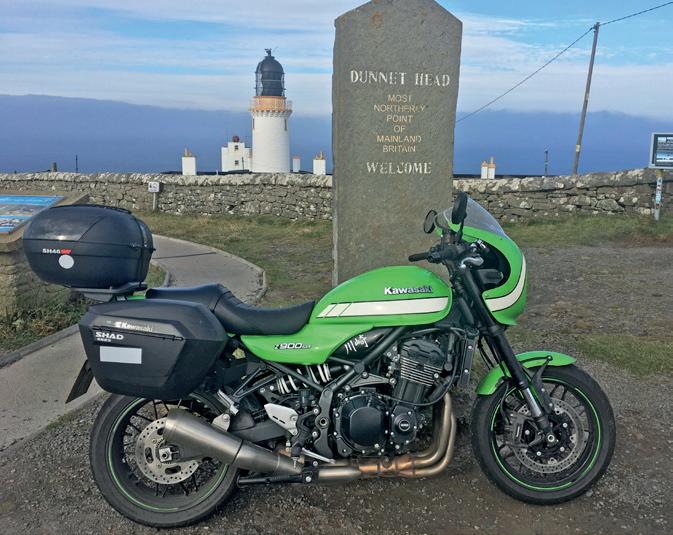
at the top of the pass and descend the hairpins. During this trip we covered 1760 miles and the Kawaski was perfect. Two years later we did the NC500 again but in the opposite direction and over fewer days. My mate who accompanied me on the first trip came along on his Yamaha Tracer 900GT, together with another friend on a Kawasaki Z900RS. Riding clockwise you get to ride the most exciting roads early on, most notably Applecross Pass. The views are different travelling the opposite way, and although I remembered the places we stopped the first time, I can honestly say it was like riding another route. You see things that you didn’t notice the first time. Personally, I preferred riding the NC500 anticlockwise as the best roads were at the end of the route, but either way is worth it. The roads are fantastic and as challenging and as good as any I’ve ridden anywhere – I enjoyed it as much as riding in the Alps.
Richard Chamberlain, Warwickshire
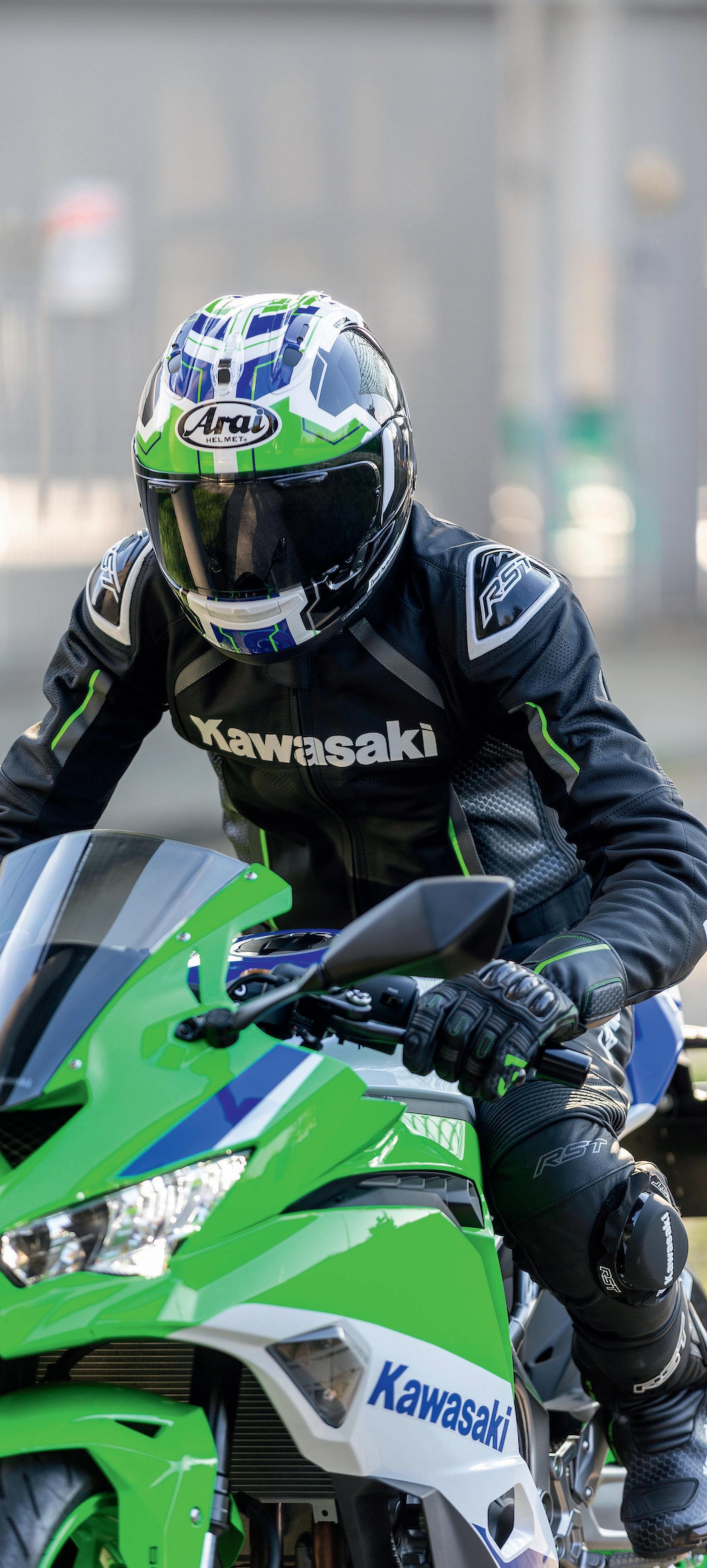


MALE
RRP RRP £258.95 CLUB £233.06
The RIMINI II leather jacket is a sports riding jacket packed with race-proven protection. High-density perforation panels and a removable full sleeve thermal liner provide interior climate control, while a full-grain leather shell offers superior abrasion and tear resistance.
ARMOUR
n CE Certification Rating: AAA
n Back protector: CE Level 2
n Shoulder armor: CE Level 1
n Elbow armor: CE Level 1
CONSTRUCTION
n Main outer material: Full-grain leather
n Inner lining: Fixed mesh lining and removable quilted thermal liner
n Collar: Leather
n Shoulder cups
n Cuff opening: Neoprene for comfort
n Connection zip: Yes
n Reinforcement: Triple stitched with bonded nylon thread
FEATURES AND BENEFITS
n 2 inner and outer pockets
n Perforated leather panels for airflow
n Waist adjustment for an improved riding fit
n Stretch panels on sleeves and sides to improve the fit
MALE
RRP £76.95 CLUB £69.26
A fantastic addition to the Kawasaki Sport riding outfit. Utilising a floating carbon knuckle, outstitched fingers, loads of stretch and motion panels. It’s a comfortable yet highperforming sports glove.


MALE
FEATURES AND BENEFITS
n 2 inner and outer pockets
n Perforated leather panels for airflow
n Waist adjustment for an improved riding fit


RRP £135.95 CLUB £122.36
Our Amiens textile jacket is a bold and vibrant take on protective motorcycling apparel. Its futuristic style and reflective panels offer increased visibility and protection. Rated CE Level AA, the jacket comes with CE Level 1 armour and back protector pocket.
FEATURES AND BENEFITS
n New improved fit
n Neoprene sports comfort collar
n Intake and exhaust vents
n Waist and sleeve adjusters
n Motion panels
n Reflective detail
n 2 x outer zip pockets
n 4 x internal pockets
n 360° connection zip

MALE

RRP £216.95 CLUB £195.26
n Reflective detail: Yes – reflex print
n Adjustment: Waist adjusters
n Outer pockets: 2
n Map pocket: Fixed


RRP £55.95 CLUB £50.36
The Kiel water-resistant touring glove has a high-tenacity nylon outer and SinAqua lining for protection from the elements, while a CE Level 1 TPU knuckle protector provides impact resistance.
MALE
RRP £156.95
FEATURES AND BENEFITS
n Reflective detail: Yes – reflex print
n Adjustment: Waist adjusters
n Outer Pockets: 4
MALE
RRP £46.95 CLUB £42.26
The DIJON II Mesh gloves are CE Certified to Level 1 KP. Made from mesh with a polyester lining, these gloves offer supreme ventilation. Protection comes in the form of TPU on the knuckle, TPR on the fingers, a memory foam thumb and full-grain double layer leather palm. This is further supported by the smart touch leather on the index finger, pre-curved fingers and a hook and loop strap closure –perfect for summer riding.
ARMOUR
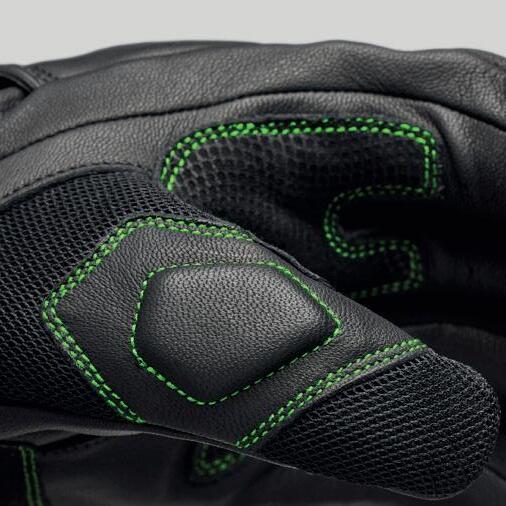
n CE certification rating: Level 1 KP
n Knuckle protection: TPU
n Finger protection: TPR
n Thumb protection: Memory foam
CONSTRUCTION
n Main outer material: Mesh
n Pre-curved fingers: Yes
n Cuff closure: hook and loop wrist closure
n Palm: Full-grain leather
FEATURES AND BENEFITS


MALE / FEMALE
RRP £36.95 CLUB £33.26
Kawasaki MXGP-Team replica short-sleeved crew neck T-shirt

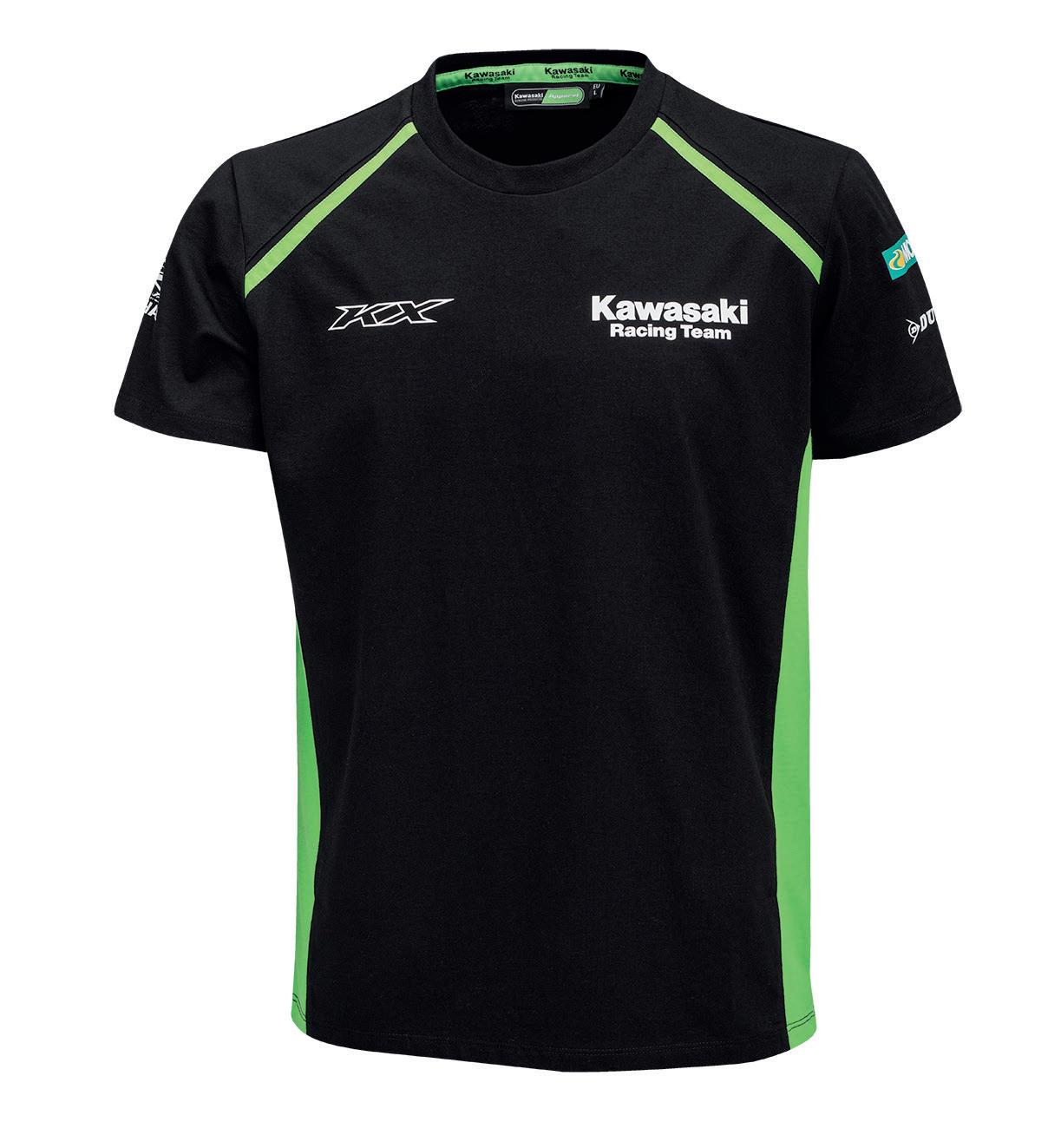
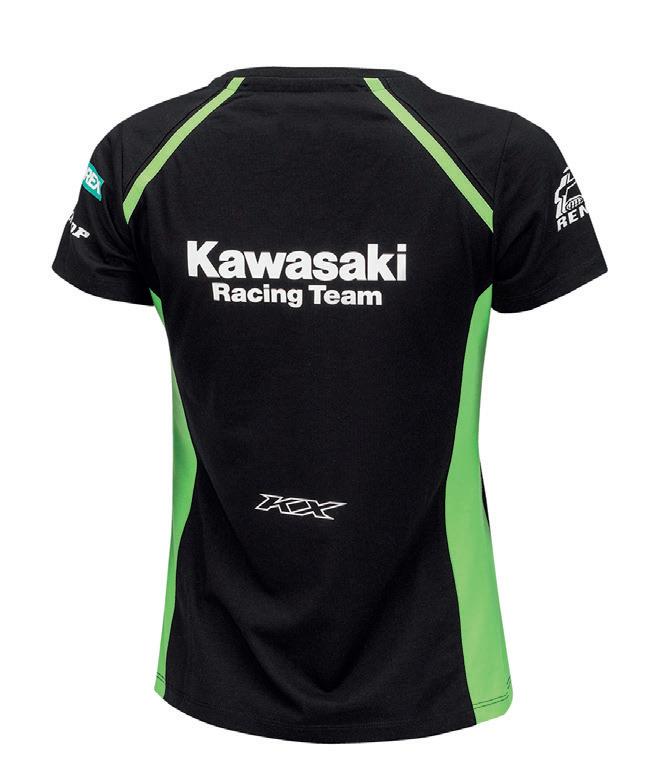
MALE / FEMALE
RRP £93.95 CLUB
£84.55
The NEUSS touring boot is packed with features to keep your feet protected. Made from a microfibre construction, the boot features a SinAqua waterproof membrane for dryness and breathability. Added to this are the integrated shin, ankle and heel protection. The boot also features an integrated reinforced toe box and is CE certified as standard!


MXGP
RRP £25.95 CLUB £23.35
Six panel flat peak cap with embroidered air holes and logos.

Adjustable snap closure
Kawasaki racing and KX logos
Twill
100% cotton



RRP £21.95 CLUB £19.75
Black and with Kawasaki green detail knitted beanie with turn-up.
n Double layer with turn-up edge
n KRT logo embroidered
n KX logo knitted into beanie
n Knitted
n 100% acrylic

If you’re new to motorcycles, the UK laws about what motorcycle test you need to pass in order to ride different motorbikes can seem complicated. We will take you through the steps you need to take to get on your way. Which motorcycle licence you’re able to train for depends on your age, any previously completed tests and which motorcycle you would like to ride.
A LEADER IN THE INDUSTRY
KRTS is a national training service provided by leading manufacturer Kawasaki. We aim to ensure safe, comprehensive and fun motorcycle training at the highest level.
TRAIN YOURSELF TO THE HIGHEST STANDARD!



imota is an idiosyncratic brand with its own way of approaching almost every aspect of motorcycle design and construction. For example, the name of the company begins with a lower case b; a great indication of the minute level of attention to detail that characterises the brand.
Perhaps better known to older motorcyclists thanks to their huge presence in the motorcycle market and media in the 1980s and then into the 1990s, bimota was not without its troubles in terms of internal issues including finance and ownership, leading to a period of enforced dormancy that did little to keep the name – or names – of the three founders on the lips of motorcyclists.
Created by Valerio Bianchi, Giuseppe Morri and Massimo Tamburini in 1973, the thrust of the company was centred on chassis design and manufacture, harnessing the best contemporary engines available in a new and innovative style framework. The HB-1 race machine emerged in that first year housing a four-cylinder SOHC CB750 Honda engine, while plans for road bike production (mostly in the guise of frame kits rather than completed machines) ramped up.
Not that bimota neglected racing as the spiritual core of the company. In 1980 the Rimini-based outfit scored their first worldwide racing success securing the 350cc world championship with a TZ350-powered machine ridden by South African, Jon Ekerold. Further success followed, culminating
in an incredible WorldSBK race win for Anthony Gobert at Phillip Island in 2000.
In terms of road machines, bimota quickly rose to become a watchword for innovative design, handmade craftsmanship and cutting-edge technology. Allied to some of the best motors of the day from Japanese and Italian manufacturers, the consumerist 1980s saw machines such as the Kawasaki-powered KB1 selling in numbers that perhaps even bimota had not expected. In fact, the KB1 remains as bimota’s top selling machine – so far.
Of course the small company would not have it their own way and, in the course of time, Japanese machines in particular gained better chassis, brakes and suspension which, for some, compromised the relevance of bimota. As we will see later in this feature, that was certainly not the view inside bimota and the advantage they had then still figures centrally in their approach to motorcycle design and creation today.
Having experienced several iterations and some well-documented financial difficulties in the past, bimota is now on a strong footing via its association with Kawasaki, and both companies share and benefit from each other in a classic win-win environment.
At the very core of bimota, the passion to innovate and lead still burns as brightly as ever, which is obviously a delight to older bikers who remember the peaks of production and innovation.Now the task is to enthuse a new, younger generation of motorcycle riders. To do this, explain what the bimota USP is, what makes it so exclusive and desirable, and, crucially, why the partnership with Kawasaki brings stability, security and a new level of engineering and technological expertise that might have just been a dream for bimota - until now.


To gain an insight into what makes bimota tick and understand why such unbridled passion runs through the veins of this small yet world-famous Italian company we spoke to Marketing Manager Gianluca Galasso.

n fact, it’s a little disingenuous to call Galasso simply the Marketing Manager as he also oversees aspects of homologation, test riding (much of which he does himself), areas of product development, distributor communications and many other tasks. Reflecting on the old adage of, “If you want something done, ask a busy man,” we stole an hour of Gianluca’s time and probed him on a few core topics…
How long have you been involved with bimota and what is your background workwise?

I started my association with the company way back in 1988. My first role was as a bimota rider for the Italian domestic championship in the Sport Production class. In that year, I also gravitated to the Superbike class, ending the season in third place behind the eventual winner Davide Tardozzi and runner-up Fabrizio Pirovano, with Fred Merkel just behind me in the points table. In TTF1, I raced alongside the likes of Carl Fogarty on our YB6 with a 1000cc Yamaha engine and YB4-EiR in Superbike fitted with a 750cc engine, also from Yamaha.
In 1990, after I won two Italian championships, bimota asked me to become their official test rider, a post formerly held by Tardozzi.
I actually left bimota a little while after this to pursue other career goals and I stopped racing in 1995. In the late 1990s, I was still test riding at bimota but also attending to technical issues for distributors worldwide. Those were tough times financially, and the company struggled. Whatever the issues, it was hard not to be part of the passion that characterises bimota, and I rejoined in 2015, working for a few months to prepare the EICMA show stand. But the overall management of the company wasn’t clear, so I sought career progression elsewhere again.
I was persuaded to rejoin once more in 2019 at the time the partnership with Kawasaki was being fleshed out, and I’m perhaps happier now than I’ve ever been.
bimota is keeping the same core ideas and approach as before. For sure, times are changing, but bimota is also evolving. We always seek to innovate and break new ground. For instance, in 1986 we started to make extruded alloy frames. Now, in 2025, we are constructing a composite frame that is different to anything else on the market.
Our focus on innovation remains. Technology evolves over time. What wasn’t appropriate 20 years ago is now possible at our level of manufacturing. Before, we could only mass produce a certain number of units for a new model to be viable, but today we can produce smaller numbers thanks to our level of human intervention and quality. Being bimota and exclusive means we deliver a unique, top-quality product where customers can tangibly see the craftsmanship, thus justifying their investment.

bimota made a billet swing arm 30 years ago, but it was using a fouraxis milling machine. Now five-axis machines are common, so we can deliver a lot more. We were first to use carbon fibre on a frame, but the technology was still young and relatively unproven. Now, 30 years later, we easily incorporate such


materials even if they’re still rare structurally on mass-produced machines.
have been the high points across bimota’s history
My oh my, that could be a long list. OK, in the early days with Tamburini we were the first to make a single progressive suspension on the rear and also the first to produce a motorcycle with a limited difference in trail during braking. We were the first to produce composite frames for the road with a steel tubular trellis incorporating alloy plates. We also forged special magnesium wheels with Campagnolo.
The YB4 had an extruded frame and – another personal highlight - the fully integrated bodywork of the DB1. Many others followed this such as Honda with the CBR1000 and 600 and also Ducati with their Paso series.
I think one of our biggest high points was introducing fuel injection for a production bike in 1988 and prototyping the system a year earlier. In 1991, the first Tesi reached production, and in 1994, the SB6 was the first bike to feature innovative self-supporting rear bodywork with no subframe.
“I think one of our biggest high points was introducing fuel injection for a production bike in 1988”
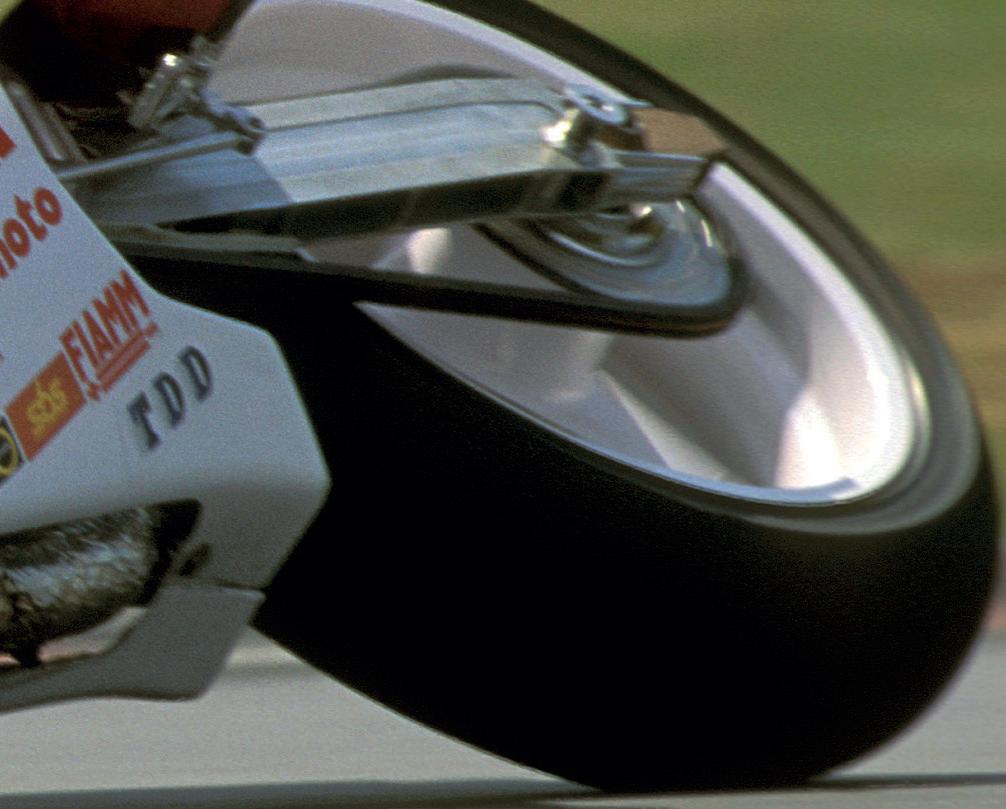
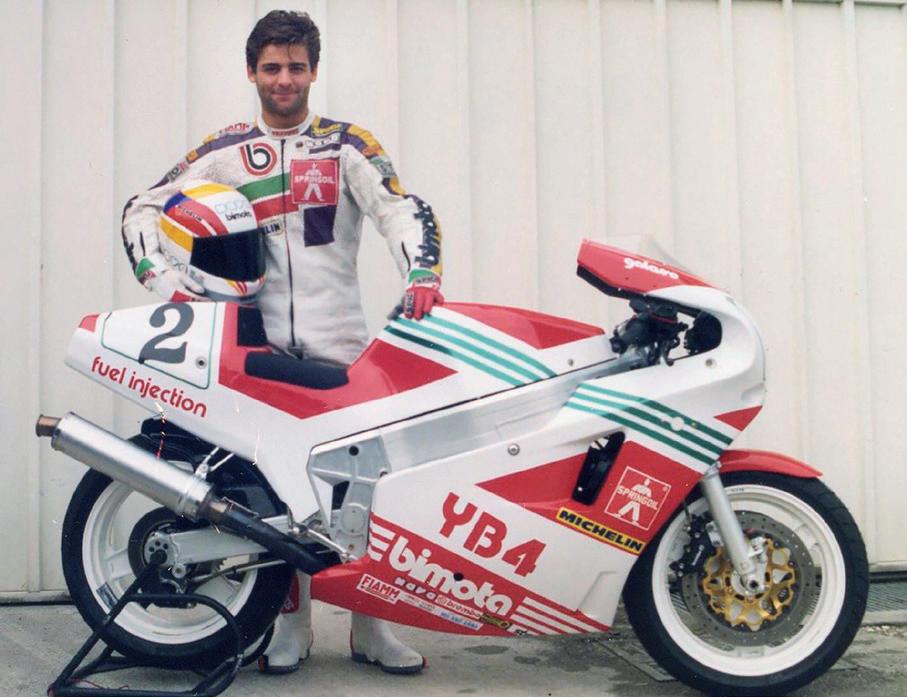
How important is the hub centre steer TESI concept to bimota and why do you think other manufacturers don’t use it?
This was and is something that defines bimota. Tesi shows the world a hint of just how innovative the company is. It fundamentally illustrates how we are always looking for new ways to approach the riding and performance experience. In 1982, it was just a drawing yet by 1983 we’d created the first actual prototype. Naturally, we wanted to race the bike, but the resources to develop it for the track were simply not available.
At first, riders were cynical of this new direction, and for me too it was a big step. In 1989, I started testing the bike and helped to refine it step by step. Now, it’s an accepted part of the motorcycling landscape, and this level of innovation gives the impetus to other manufacturers to follow this path, such as Yamaha with the GTS1000, BMW
with Telelever and even some aspects of the Gold Wing suspension system.
The negotiations between bimota and Kawasaki were super-secret. In all, the deal took around three years from start to finish. In March 2019, something emerged regarding an entity called “Italian motorcycle investments” which was a corporate tool to kickstart activities with suppliers. The news spread in the motorcycle world, but we tried our best to keep it a secret. Around July or August, rumours gathered pace and the story gradually evolved.
Understandably, everyone involved had been deeply unhappy about the decline of the company, and even after rumours of the deal in July, people were sceptical about its authenticity. It was only when President of Kawasaki Motors Japan, Hiroshi Ito, made things clearer at a press conference at the EICMA show in November that we could breathe again as a company and feel a tide of optimism and energy pervade all the employees – it was a great day.
Security and stability are the two main words we now use around the company. Also, this partnership provides incredible advantages in terms of reliability and integrity. I don’t necessarily mean the motorcycles themselves, but everything relating to support services such as a dealer intranet and other Kawasaki systems that we can adapt and customise to become bimota systems.
Put simply, if bimota had entered a partnership with a normal investor (not that we would ever again!), the amount of money to make a motorcycle would be prohibitive because we would need to create “back office” systems. We can now count on huge advantages such as homologation of engines and other allied technologies. This unification helps us immeasurably.
Give us your feelings about the BbKRT race programme – what effect has this had on the whole bimota company?
For us, it offers many crucial advantages. bimota is a small company with just 15 people, and with the best will
in the world, 15 people can’t race in the WorldSBK.
The BbKRT staff are more than 40 strong and can rely on an existing Superbike infrastructure in Provec that has won the championship seven times. Nothing is better than this and for sure, we couldn’t hope to match these human, financial and technical resources.
Everyone working at bimota, from top to bottom, is happy and enthusiastic about this team. They want to see it, feel it and to be involved, but we have to accept that we

I always dream and I like to think big, so our hope is to be as good in our own unique way as Kawasaki has been until now. We are in partnership with this huge, global entity and we judge our potential alongside Kawasaki’s high standards.

An advantage to being small is that we’re flexible, and we have to use this advantage to be competitive, not only


For the 2025 season, bimota is partnering with Kawasaki in a joint venture which will result in a bimota chassis with Kawasaki engine (plus allied technology), competing in WorldSBK. Not only will the donor Ninja ZX10RR powerplant be familiar but also many of the team staff. Kawasaki is transferring its efforts into the bimota racing programme, marking a landmark moment in the journey of the Kawasaki Racing Team after nearly four decades in the premier global racing series based on production machines.
This year, we are pleased to announce we are offering hospitality for Club Kawasaki members at the UK round of WSBK at Donington Park on Saturday and Sunday!
Price is £320 per person WEEKEND TICKETS INCLUDE
n Weekend admission - from 11 to 13 July
n Saturday and Sunday suite access and hospitality – 12 and 13 July
n Morning coffee with a hot breakfast roll
n Buffet lunch
n Afternoon tea and cakes
n In-suite bar serving house wines, beers and soft drinks
n Television with live feed and timing
n Parking pass – 1 per booking
n Directors’ Suite – the best views of the circuit with balcony on three sides of the suite, located by Goddards
n Rider appearances from Kawasaki Racing Team – subject to timings and team discretion on the day
Get tickets here: www.club-kawasaki.co.uk/shop
Kawasaki unveiled the future sensory off-road mobility “CORLEO” concept model at the EXPO 2025 in Osaka, Japan
CORLEO, which sat comfortably under the exhibition theme “Impulse to Move”, is a future sensory off-road personal mobility machine featuring four-legged mobility, stability and technical innovation, a proposal made possible by the Kawasaki Group, whose businesses include motorcycle manufacturing and robotics.
This revolutionary off-road vehicle comes under a new category of Personal Mobility that values the “Fun to Ride” features of Kawasaki motorcycles and offers excellent all-terrain capability, powered by four robotic legs, together with the handling and stability of the company’s bikes.
While preserving the joy of riding, the vehicle continually monitors the rider’s movements to achieve a reassuring sense of unity between human and machine. Two wheels, four wheels and now four legs – Kawasaki innovates again with CORLEO!


An instrument panel displays information including hydrogen level, route to the summit and centre of gravity position. At night, it supports optimal riding by projecting markers onto the road surface to indicate the path ahead.

The four legs are equipped with hooves featuring a left-right divided structure made of rubber, a material that absorbs surface irregularities and is slip-resistant. These hooves can adapt to various terrains, including grasslands, rocky areas and rubble fields.


The rear leg unit can swing up and down independently from the front leg unit allowing it to absorb shocks while walking and running. Additionally, when climbing steps, the rider can maintain a posture that avoids looking upwards, making it easier to check the road conditions ahead.

The rider can control the machine through weight shifts detected through the machine’s steps and via the handlebars. By changing the length of the stirrup, the rider can maintain an optimal posture.

Equipped with a 150cc hydrogen engine for power generation. Hydrogen is supplied from a canister mounted at the rear. The generated electricity powers the drive units installed in each leg.

What does it take to visualise, plan and execute a European launch event for a new motorcycle?
Come join us as we head to sunny Benidorm for the...
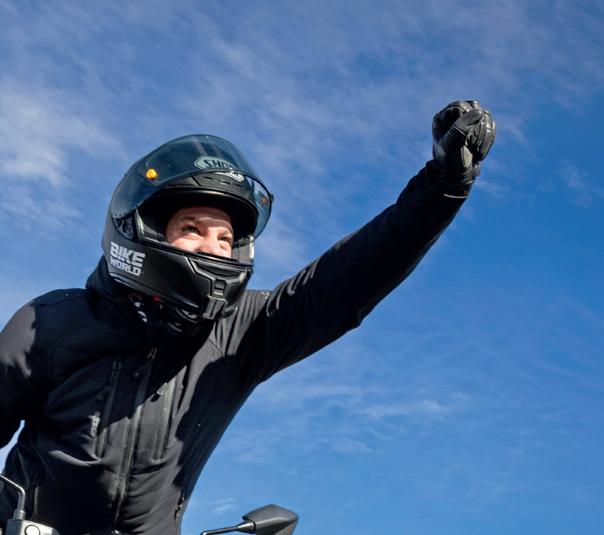


The launch of a new motorcycle is an incredibly important moment for the manufacturer as it’s the first real-world impression of how the bike is going to be perceived. For the 2025 Kawasaki Z900, the launch took place in sunny Benidorm. Kawasaki Europe hosted a no-holds-barred media introduction that brought together journalists from across the continent to experience this heavily revised Supernaked on the smooth tarmac snaking around the hills of the Spanish holiday hot-spot.
These events are the first glimpse the public gets of a new machine, filtered through the eyes and experience of the UK’s media. But behind the fancy photos is a group of dedicated people whose goal is for our new model to receive the best reviews possible.
The story of the Z900 European debut started thousands of miles away in Japan, where Kawasaki’s engineers and designers refined its aggressive styling and applied a suite of enhanced







electronics to complement the signature 948cc inline-four engine. Some of the first machines off the production line were shipped to Europe, specifically Kawasaki Germany, where they were uncrated, PDI’d and prepared ahead of the event.
The media introduction kicked off with a presentation that was part technical deep-dive, part explanation of the machine’s key features and its positioning in the marketplace. Kawasaki’s resident PR guru, Martin Lambert, took to the stage to walk journalists through the Z900’s latest evolution. While attendees will have received an initial press release, this 45-minute enhanced delivery ensured they fully understood the updates from concept to reality. The journalists from each country had a representative from each Kawasaki branch with them for the duration to make sure further questions were answered and that they had a good time. After all, if they go away from the launch smiling, the reviews tend to be even better!
The main element of the event was the ride itself. Kawasaki’s staff work closely with an outside agency scouting the perfect route – a mix of technical and winding corners, fast sections and open motorway to let journalists push the Z900 to its limits in all riding environments. The chosen 150-mile loop in southern Spain was designed to highlight the bike’s agility, power and updated features, such as its traction control system and new quickshifter. Kawasaki worked with local authorities to give them advance warning of the event and to gain consent to close the road at the photo and video locations.
The team also flew a drone above the riders, following them through the winding section of road



The photo and video section of the event is paramount. We of course want the bike to feature on the front covers of magazines, so the best-looking shot is really important. A section of road around two miles long was closed off so journalists could ride freely without worrying about oncoming traffic. We offered tracking shots where the journalist rides closely behind a car with our photographer sitting in an open boot to capture that perfect riding image. The video tracking element was where it got really high-tech as the guys from GSP Media remotely controlled the video equipment mounted to the back of their van, while videoing the journalist as they moved from side to side. Impressive stuff. Not content with simply ground-based footage, the team also flew a drone above the riders, following them through the winding section of road offering up maximum shot selections for the YouTubers invited to the event.
Equally critical is hospitality. The first part of the trip was the hotel, which offered journalists a comfortable base to rest, review



notes and file stories. Planning a guest list for around 150 people travelling from all corners of Europe was tricky to say the least, but branding a hotel with Kawasaki signage, bikes and promotional items, plus organising a presentation room and various catering options, made it a huge job! Kawasaki recruited the services of Spanish agency CROM, which has a long history of organising events around the world, to assist in this area especially. And as many of our launches are held in Spain, knowing the local lingo certainly helped.
None of this would be possible without Kawasaki’s team of technicians, arguably the unsung heroes of the launch. Days before the event, they unpacked the Z900s, inspected every component and fine-tuned each bike to perfection. During the event they were on standby, ready to address any mechanical hiccups or swap bikes if a journalist wanted to test a different configuration.
One popular part of our launches is the ‘free ride’ back to the hotel after the lunch stop. Once journalists sampled local

delicacies in beautiful surroundings while discussing the merits of the new bike with their peers and Kawasaki Europe staff, they rode back to the hotel solo with a TomTom sat nav to guide them. This allowed them to fully understand the bike at their own pace, and to also stop and record their own video reviews. We are the only manufacturer offering this part of the trip and it doesn’t go unnoticed with the European media.
The technicians also played a key role in educating journalists about the Z900’s features, explaining how to toggle between riding modes or adjust the new suspension settings. Their expertise and calmness under pressure kept the event running smoothly, even when a bike needed a quick fix after an overzealous journalist pushed it a bit too hard, or they needed to contact engineers in Japan to confirm a technical aspect of the bike. The tasks were never-ending and we fully appreciate the time and effort they contributed to the event.
As the launch wrapped up, journalists filed their stories and the first reviews of the 2025 Kawasaki Z900 hit the internet. Words like “refined,” “thrilling” and “aggressive” dominated the reports, accompanied by jaw-dropping photos and video of the bike in action.
For Kawasaki, this media introduction certainly paid off. You never quite know how your bike is going to sit with journalists, so the months of planning, thousands of miles travelled and countless hours of work that boiled down to a single day of riding to shape the bike’s reputation can be quite stressful! However, the 2025 Z900’s European debut was a testament to the teamwork, dedication and execution behind this highly anticipated launch.
As the journalists packed their bags and the Z900s were re-crated for their next destination, Kawasaki’s team took a moment to relax and reflect on the event. With normally around six to seven events like this organised each year, it’s a never-ending merry-go-round that takes a lot of meticulous planning. As we now look forward to the next event, which for now sadly has to remain a secret, you can rest assured the planning has already begun! n


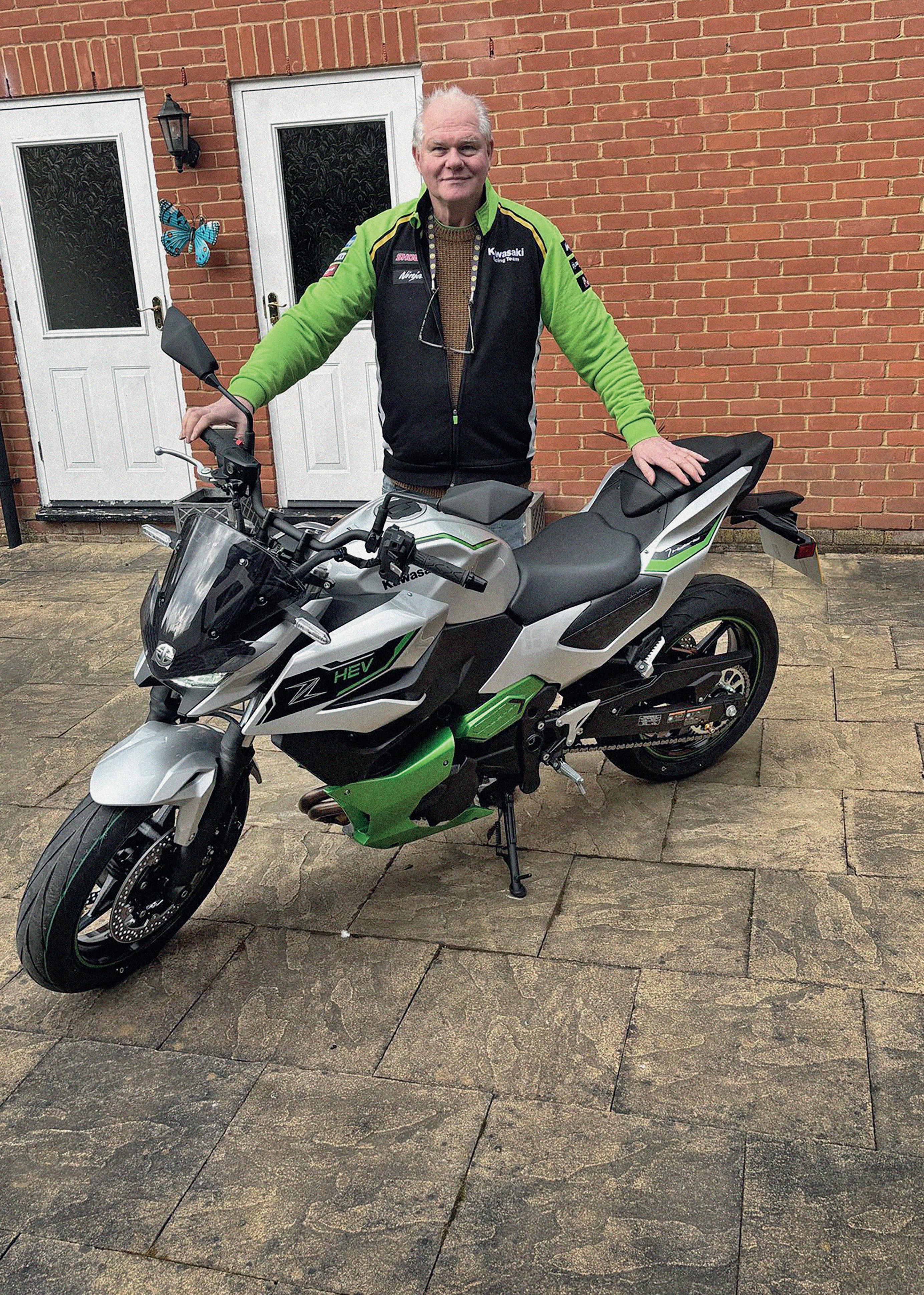
me & my kawasaki
Traditionalist, petrolhead and Z1 restoration legend Dave Marsden is totally won over by the radical Kawasaki Z7 Hybrid
To Z fans, rebuilders, collectors and obsessives, the name Dave Marsden is talked about with reverence. A one-man Kawapaedia, Dave was, until recently, at the helm of Z-Power, the Huddersfield-based company specialising in original and reproduction parts for Kawasaki Z family machines, as well as commissioning copies of rare parts no longer available.
A self-confessed petrolhead with a documented love of 1970s and ’80s air-cooled Z family bikes, Dave is top of the least likely list to adopt any of the new smoke and mirrors modern technology; yet he has jumped in with both feet and recently purchased a Z7 Hybrid. Here are his thoughts…


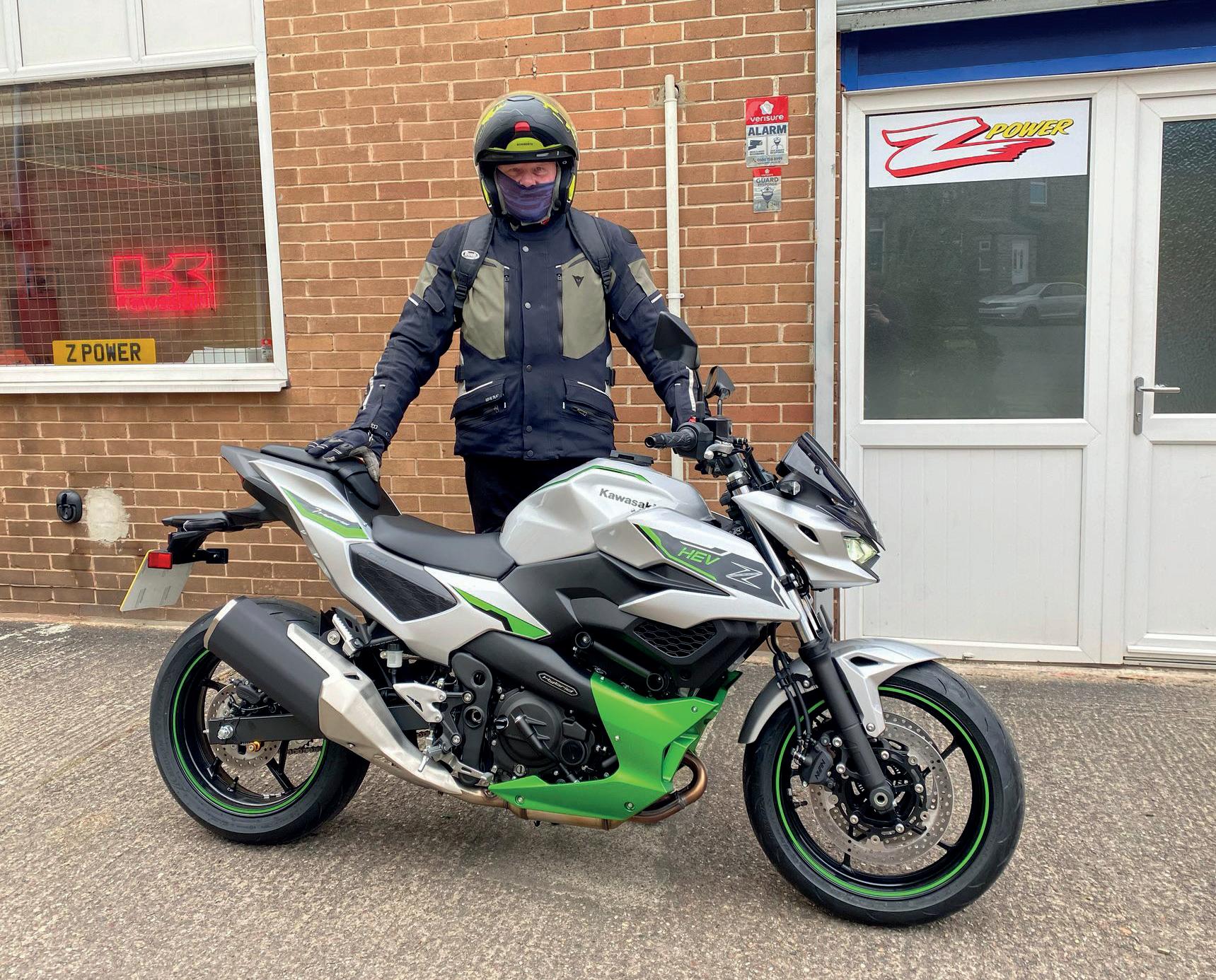
“At the tender age of 66 and with two hybrid cars in the family already, I thought it was time to look at the Kawasaki Z7 hybrid, especially now as prices for new machines have been lowered. And what a surprise –in a good way!
It may only be a 450cc petrol-engined twin, but wow, I can see why Kawasaki called it a “7”; it performs just like a bike twice its size. To be honest, it would be just great without the added electric motor, especially as a commuter bike, which is why I bought it. But now I can see myself using it for much longer rides.
I have owned automatic bikes (ahem – from other manufacturers), so the lack of a clutch lever and gear lever was not new to me, but I do remember the first auto I had and that panic moment of reaching for the ‘missing’ clutch lever!


Actually, it’s surprising how it becomes second nature in no time. The Z7 can be used in full auto and manual mode using the paddle switches located on the left handlebar, except in sport mode where you have to change up, but the bike will change down for you automatically if you so wish. Talking of sport mode, the e-boost button on the right switchgear is incredible.
Whenever you need a burst of extra speed you just push the button and get an instant surge from the electric motor, which feels like a nitrous injection boost – truly amazing, and it can be used many times before the battery shows any sign of running out of charge. That boost makes overtaking a breeze, and I found I was also just using it for the fun factor, so it’s a typical Kawasaki in that way in my opinion. On full boost it felt more like a 1-litre bike, never mind a 700cc. Every bike should have one!


All this and it was still showing an average of 72mpg –what more could you ask for?
Engine and motor aside, the Z7 is a great bike in its own right. Great handling, light to manoeuvre despite the extra weight of the battery and electric motor, and great brakes. The ride is smooth, seating position spot on and the colour TFT dash easy to read. It even looks great without being fussy or over-gimmicky.
There have to be compromises with the size of the packaging and the battery, and the bike will only do 44mph in full EV mode, with a range of around 8-10 miles because otherwise I would ride in this mode all day!
I love the way it sets off in EV mode in the ECO mode before it turns to the ICE mode, quietly and then
“On full boost it felt more like a 1-litre bike, never mind a 700cc”
seamlessly into fully auto mode. In EV mode, people look at you as you ride by, confused by the lack of noise, and when you stop everybody wants to know what it is, what it does and how to get one.
Maybe Kawasaki answered a question that nobody asked, but if you get a chance, test ride one; it will certainly put a big smile on your face.”
There you have it. What seemed like dyed-in-the-wool traditionalist won over by the charms, performance and unique qualities of Kawasaki’s hybrid. For sure people have taken Dave’s word as gospel for decades, but if you want to be 100 percent sure yourself, track down a Kawasaki dealer with a demo and join the clean, green and clutchless hybrid age. n
The story of the Champions Flat Track School began with a simple idea: introduce the sport of flat track racing in the UK and give customers the chance to hone their skills in a controlled and fun environment. You can argue that founder, owner and Head Instructor, Pete Boast, has done just that – in spades!
Recently, we visited the school, based near Market Rasen, Lincolnshire, to catch up with Pete. We also took the opportunity to invite a few of the 2025 AJN Steelstock Kawasaki British
Superteen racers to test out the recently acquired KLX140s around the oval track.
Flat track’s benefits extend far beyond its own races, Pete tells us. “For superbike riders, it’s 100
“We’ve had riders like Jonathan Rea come through the school. It’s the best training – better than a gym”
Pete Boast, Champions Flat Track School
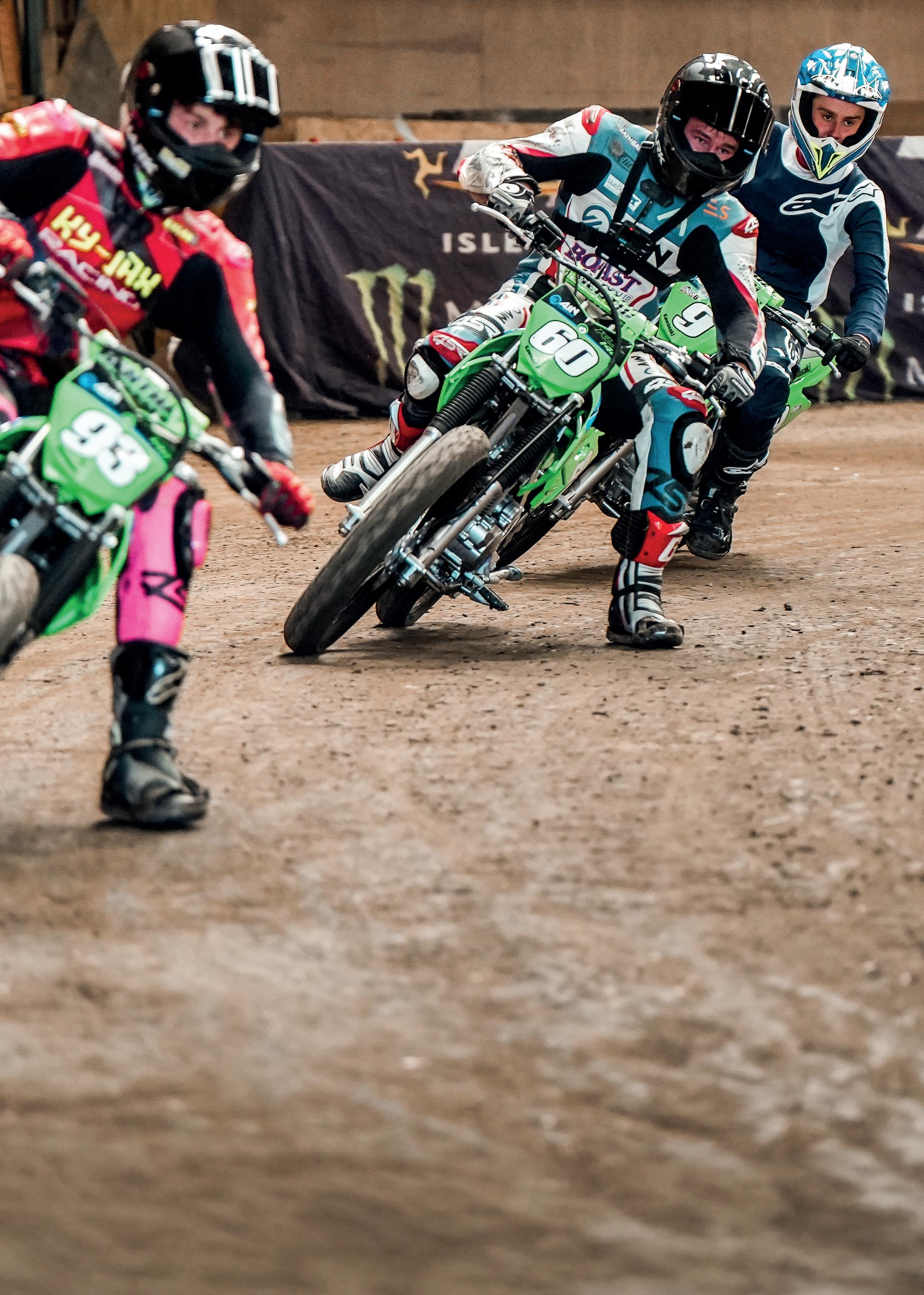
percent valuable. We’ve had riders like Jonathan Rea come through the school. It’s the best training – better than a gym. If you’re a motorcycle rider, you need to be on a bike. The controlled environment helps too. It’s not massively risky compared with other bike racing. It’s pretty damn safe so attracts many road racers, starting from the Superteen youngsters we have with us today.”
For your average road rider, however, the skills earned also translate directly. “How many times does a road rider hit gravel or chippings? Riding on dirt builds confidence and feel and could very well save a crash on

Looking to improve your riding in a safe but exciting environment? You’ll be looking to go fast, turn left. Welcome to Lincolnshire’s Flat Track School
the road.” The tight indoor track also sharpens turning skills, a bonus for any rider.
Pete’s personal racing journey has been extensive to say the least. He began as a schoolboy scrambler, inspired by his grass-tracking father. At 16 he switched to tarmac and spent the following years racing in the British Superbike Championship against the likes of John Reynolds and at the Isle of Man TT racing with Joey Dunlop, achieving several top 15 results. However, after watching the Steve McQueen film On Any Sunday, in 1993, Pete was inspired to switch disciplines and try his hand at flat track
racing. He travelled to the US, where he quickly found out that the level was very high and unfortunately he couldn’t make it at that stage. Returning back to the UK, his decorated history of racing moved to nine years of Speedway, during which time he took the Premier League title with Sheffield in 1999. Pete’s second stint of Flat Track racing was far more

successful, culminating in National and European Championship titles! By 2013, Pete’s focus shifted to training, though the racing bug never left him. Now 60, he’s still very much handson at the school. “I nearly raced with the kids today,” he laughed.
“I can’t ride like I used to, but I can still certainly mix it with them.”
Flat Track racing, an American-born

The school uses a fleet of Kawasaki KLX140s, chosen for their userfriendliness

discipline, took some time to catch on in the UK. “It’s like bringing baseball or NASCAR over here! Motocross, trials and road racing have always been here, but flat track is relatively new. After speaking to the Auto Cycle Union (ACU) back in 2005, they basically gave me the go-ahead to work on building a presence in the UK, and since then it has steadily grown. Now, at a DTRA race meeting, you’ll see nearly 200 riders. That’s the norm.”
The sport has diversified too. “It’s not just modern or vintage bikes – riders are on modified motocross bikes now. The fast boys are usually on 450 four-strokes like the KX450.” The sport’s growth has gone global, with a European Championship and an FIM World Championship now in play, and TV coverage coming this year. Tracks
“We cater to a wide range of riders, from complete novices to seasoned pros”
Pete Boast, Champions Flat Track School
are popping up everywhere and are being used for flat track and road racing training.
In the UK, two British championships now exist: the DTRA (Dirt Track Riders Association) and a revived ACU series. Converting a motocross bike for flat track racing is actually surprisingly straightforward. Lower the suspension at both ends, swap the front wheel to
a 19-inch, put on dirt track tyres and you’re good to go! There are various types of flat track racing, including half-mile, short-track and TT events. Most of these are held on oval circuits where no front brake is allowed, but the TT-style events are much more technical tracks and the front brake is necessary.
We asked Pete why he has chosen the Kawasaki KLX140 as his preferred machine at the school. “It’s just so user-friendly and mellow. We decided we would go for the mid-height version – juniors can handle them, and adults ride them just as well. It has an electric start, great brakes and smooth power delivery. A KX450 would scare the hell out of a beginner, but the KLX140 teaches technique perfectly.”
The school is incredibly inclusive
as Pete explains: “We cater to a wide range of riders, from complete novices to seasoned pros. Level One is for road riders, or people who haven’t had much dirt riding experience but want to try off-road. We teach the absolute basics – technique, upper body position, how to move around on the bike and how to really feel the connection between the handlebars and the tyres on the surface.”
Level Two steps it up for those eyeing a racing future. “It’s more advanced, more race-focused. We get a lot of riders thinking about going racing at that stage.” Beyond structured courses, the school offers open practice sessions where riders can bring their own bikes or rent one. “We also do private hire days for companies and groups of mates. Anyone into bikes

can come for a day or evening.”
The crown jewel of the school is the race series. “We run a full-on race series during the winter. Kids from six years old are part of the action, and our oldest rider is 71! We’ve got a great range of abilities, plus we have a few

Inclusiveness, regardless of skill level, is a key feature of the school
ladies racing too. It’s great to see.”
The school is very much in full swing and there are plans to make it bigger and better. We look forward to seeing how the school and flat track as a sport continue to grow in the UK over the coming years. n

There’s only one machine for the man who wrote the book on touring – the Ninja 1100SX SE Tourer
Words Dexter Scull. Pictures Chippy Wood & Simon Weir
have kawasaki, will travel

When you’ve been road-testing bikes for nearly two decades, ridden all over the UK, Europe and the world, written four best-selling motorcycle touring guides – not to mention editing RiDE magazine – it’s natural to be particular about what bike you want for touring. So what does Simon Weir ride? His own bike is a 2017 Kawasaki Z1000SX – but he has his eye on the new Ninja 1100SX SE Tourer.
“I love my SX,” he says. “I ran it for a year as a long-term test bike on RiDE and just didn’t want to give it back. A week after returning it, I called up Kawasaki and UK and asked if I could buy it. That was one of my better decisions.”
What is it that he likes about the SX? “I’ve always liked that engine. If you go back down the family tree, I loved the ZX-9R from which the motor was developed. When the first Z1000 appeared in 2003, I loved that too – but a naked bike doesn’t suit my touring style,” he explains. “So when the Z1000SX arrived in 2011, that seemed ideal.
“It was interesting to watch the evolution of the model,” he adds. “That gen one SX was a great ride, but I wasn’t so keen on the panniers that mounted on a frame. The gen two was much slicker, with properly integrated panniers and a greater level of refinement. I remember riding it on the launch in Austria and being really impressed. Then after riding the 2017 model on the launch in southern France, on some of my favourite roads, I knew it was the right bike for me.”
At the start of 2019, Simon left RiDE magazine. “I was getting divorced, my kids had left home, I’d had enough of the job, so my plan was simple: ride the bike to Australia,” he explains. He swapped the hard sidecases for a gigantic topbox, huge soft panniers and a rollbag crammed with everything for life on the road, then shipped the bike from Heathrow to Toronto, Canada.
“I’d given myself four months for the trip,” he says. “The plan was to spend five weeks in the US, seven to nine weeks riding down through Latin America to Santiago in Chile, then freight the

bike to Australia and have the rest of the time there.”
He started by crossing from Canada to Niagara Falls in the US, heading down through the forests of New York State and into Pennsylvania to follow the Appalachian Mountains. He rode Skyline Drive and the Blue Ridge Parkway, Virginia, before hitting the Tail of the Dragon, North Carolina, and Cherohala Skyway, Tennessee. “I was heading for Jacksonville in Florida, where I had the bike booked in for a service,” he explains.
“My original plan was to go from there to New Orleans, but Hurricane Barry – yes, really – was battering the coast and threatening to flood it, so instead I went north along the coast then inland through the Okefenokee Swamp to Memphis.”
The next dream destination was Pikes Peak Highway in Colorado. “That’s a long way from Tennessee, though,” Simon says. “I asked a rider I met at a diner what good roads I should take along the way and he just told me, ‘They’re called flyover states for a reason.’ So I knuckled down and did 1100 miles over the next two days.”
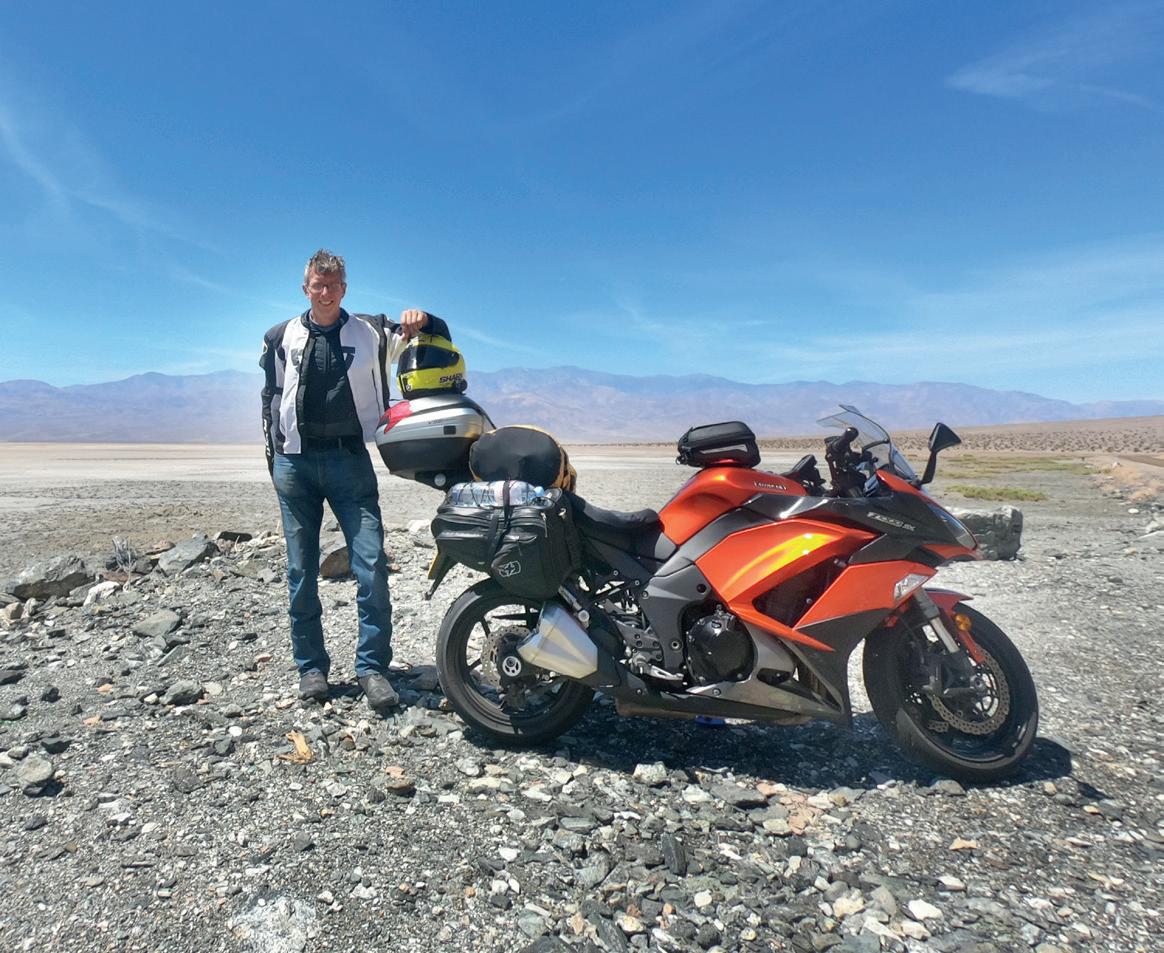
From Pikes Peak it was a roll-call of great destinations: Million Dollar Highway; Four Corners and Monument Valley; Grand Canyon; Bryce Canyon; looping through Utah back to Denver in Colorado in search of tyres. “What we think are normal tyre sizes over here can be hard to find in the middle of the US, where it’s all Harleys or dirt bikes,” Simon explains.
From Denver, it was a short ride up Mount Evans (now called Mount Blue Sky Scenic Byway) – America’s highest paved road – then a longer trip through the Rocky Mountain National Park to the Sturgis Motorcycle Rally. “I think I was the only Kawasaki in South Dakota,” says Simon. His progress continued past the Devil’s Tower to Yellowstone National Park, Wyoming, on to Yosemite National Park in California, down the Pacific Coast
“But the real highlight for me was coming back through Death Valley. It was 50C and just stunning”


a



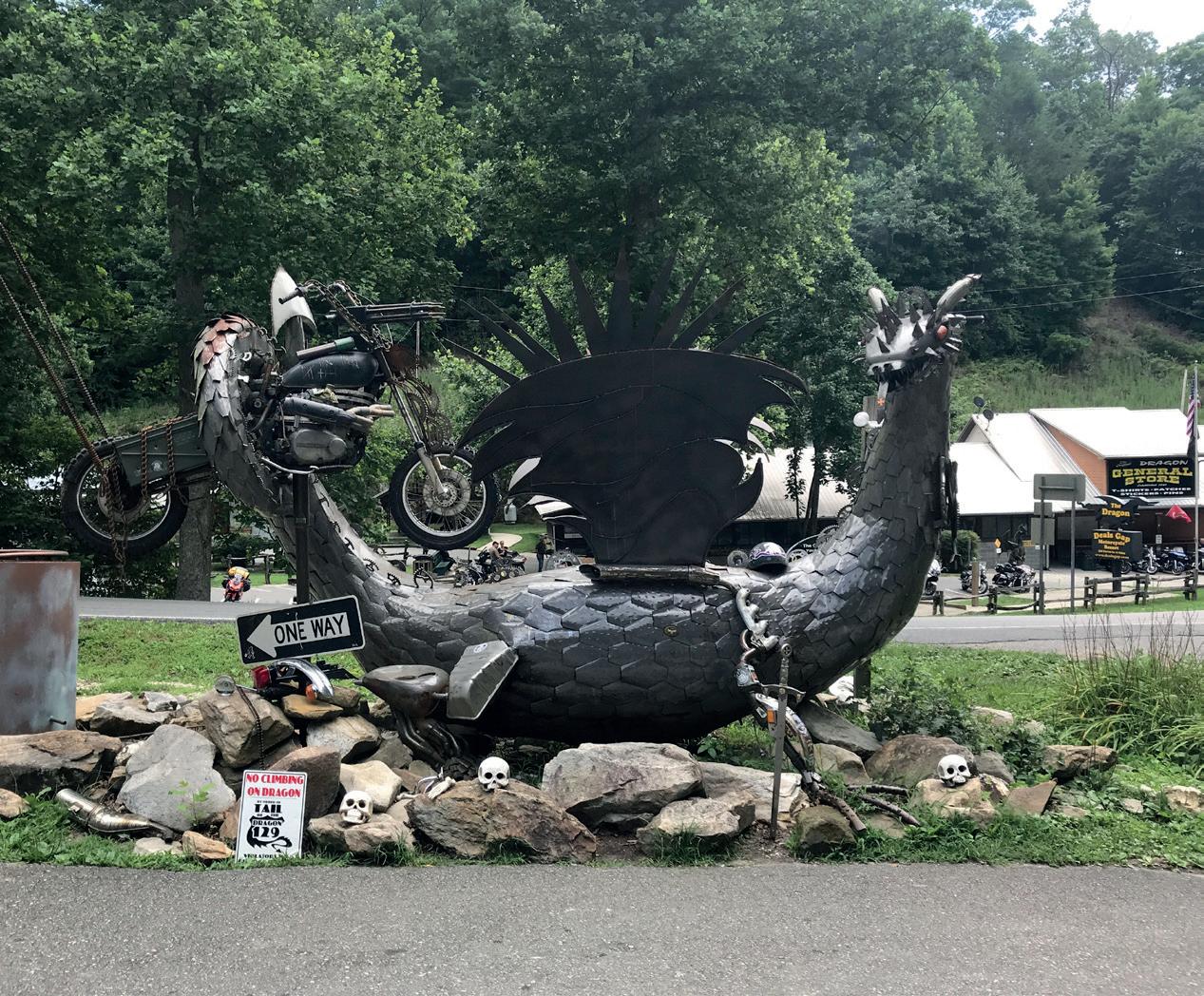


Highway to Monterey for another service. Then he swung back inland through Joshua Tree National Park. “I wanted to see the other side of the Grand Canyon and Las Vegas,” he says, “But the real highlight for me was coming back through Death Valley. It was 50C and just stunning.
“America was so much better than I’d expected, but it was expensive. I’d aimed to spend a third of my time and half my budget there, but I’d spent half the time and three-quarters of the budget. So I gave up on trying to ride through Latin America and shipped the bike to Australia. It took four weeks but cost only $500. Air freight would have been $5500.”
That left only a month for exploring Australia. “It was still the highlight of the trip. There was so much amazing riding in the mountains on the east coast, along the Great Ocean Road and on Tasmania,” he says. “Yes, there were some long, straight roads – but nothing America hadn’t prepared me for. By keeping to the hills and mountains, most of the trip was on fabulously twisty roads.”
Simon returned to the UK just in time for the Covid-19 pandemic. “I went a little bit stir crazy in the lockdown,” he admits. “When you go from riding hundreds of miles every day to being shut inside your house, you have to escape mentally.” He began by assembling all his favourite routes from 30-plus years of riding in Europe, building up a collection for his website and what would become the best-selling book Europe for Bikers
“I’ve been riding on the continent since I was 18,” he explains. “For 10 years on RiDE I was producing touring guides to the various countries. Most years I’d do seven or eight trips to Europe. There’s so much more good riding out there – and I keep finding more.” Since the end of the lockdowns the trusty SX has taken him to Switzerland, Slovenia, Spain, Scotland and pretty much everywhere in between.
So how does the new Ninja 1100SX SE compare with old faithful?
“It’s an improvement across the board,” Simon admits. “The best thing is there’s a lot that hasn’t changed – the riding position, the screen, the excellent mirrors and headlights, the build quality and the way it handles.
“But the engine is more flexible, the SE’s Öhlins rear shock is more refined and the taller fifth and sixth gears improve the fuel economy. That sounds like a minor thing, but tank range matters when you’re touring so that’s a really big plus. And of course it has the quick shifter, cruise control and colour TFT dash that my older model doesn’t have. Across the board, the Ninja 1100SX SE Tourer is a better bike than mine,” he concludes. n

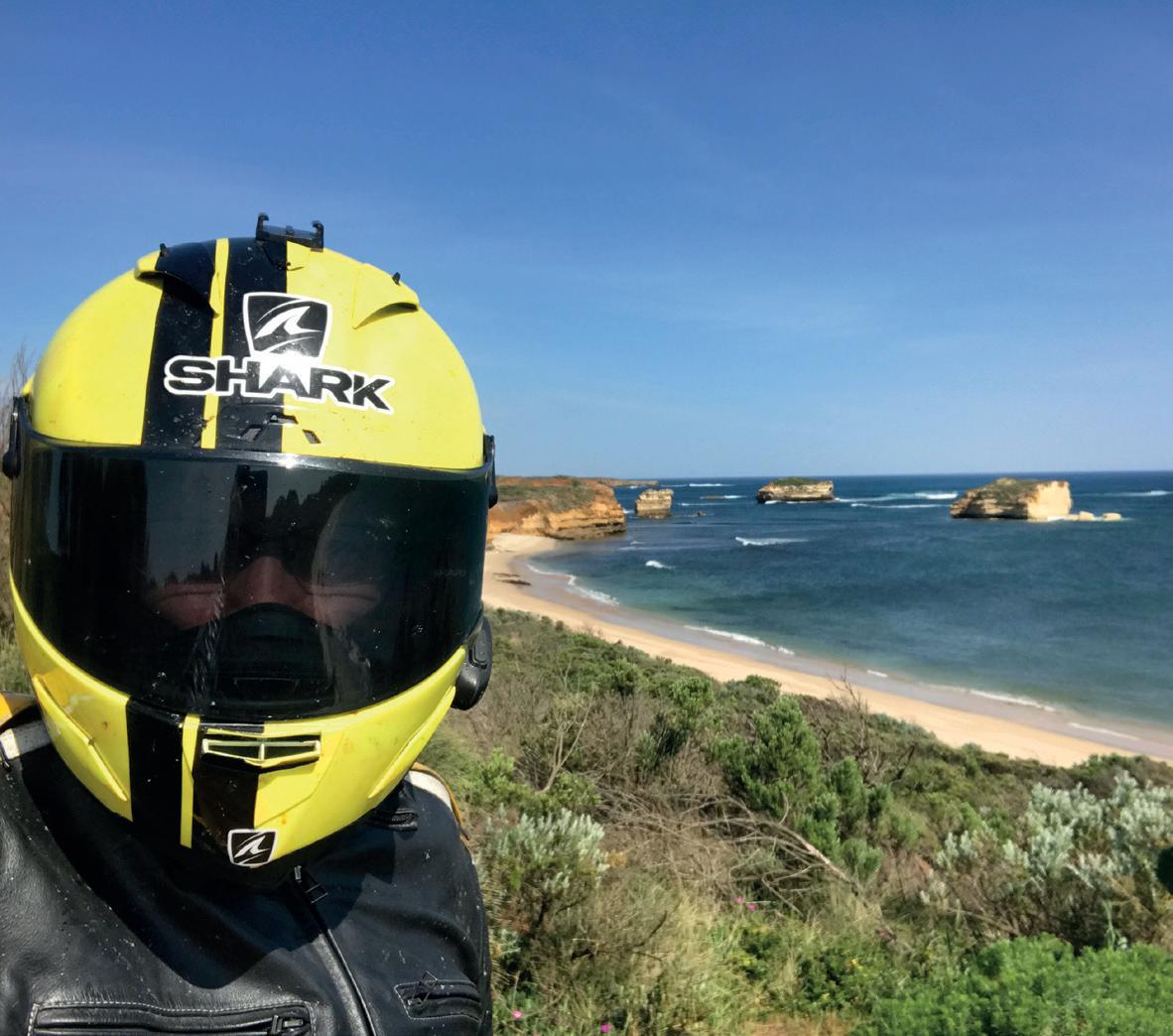


It’s safe to assume Simon had the only UK-registered Z1000SX at Sturgis!

With more than 300 daytrip routes in the EU and over 400 in the UK, plus 22 complete self-guided European tours www.simonweir.co.uk is your ultimate riding resource.
The daytrip routes are simple GPX-file downloads or sat navs (Garmin, TomTom) and sat nav apps (Scenic, MyRoute-app, Rever, Riser Pro), while the self-guided tours come as interactive eBooks of notes, with the option of hard copy maps –all supported by GPX files.
You can also use the website to get signed copies of one of Simon’s books – or one of his T-shirts. “Most of my designs use the same slogan: Ride More,” he says. “And that’s the whole the idea of the website. These are all tried-and-tested routes that make it easy for you to go somewhere new and have a guaranteed good ride.”

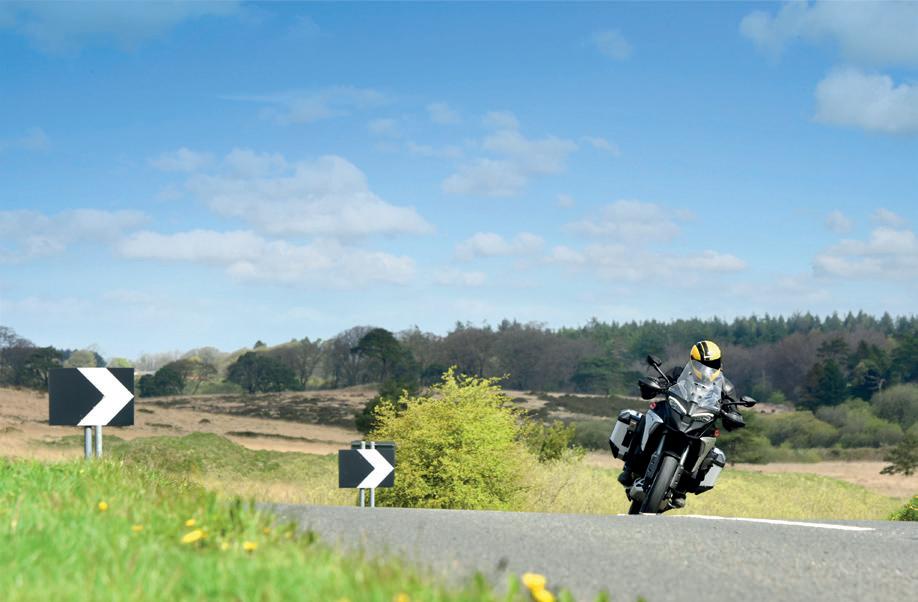

While the S1000SX takes a rest, the Ninja 1100SX springs into action








For Kawasaki owners, the thrill of the ride is often intertwined with the beauty of the natural world. Thankfully, the British Isles have a tapestry of national parks that offer havens for nature lovers with beautiful landscapes and amazing roads perfect for a day trip or longer adventure. Here, we identify some of the motorcycle-friendly destinations, as well as highlighting nearby 2025 Club Challenge locations so you can combine your ride with a bit of friendly competition…

There are 10 national parks in England, from the rugged peaks of the Lake District to the gentle slopes of the South Downs. For Kawasaki riders seeking scenic routes and breathtaking vistas, two areas stand out.
The Peak District National Park – the UK’s first – reaches into Derbyshire, Cheshire, Staffordshire, Yorkshire and Greater Manchester, offering a fantastic blend of challenging roads and moorland scenery. Winnats Pass, a steep limestone gorge on the way out of Castleton, Derbyshire, is a must-ride. The Snake Pass (A57) provides a thrilling 14-mile route with sweeping bends and panoramic views between Glossop and Ladybower Reservoir. The Cat and Fiddle Road (A537) between Buxton, Derbyshire, and Macclesfield, Cheshire, needs little introduction and is notorious for its demanding corners. Just be
aware of the average speed cameras. The Peak District National Park also offers fantastic viewpoints, including the Heights of Abraham and Monsal Head, popular biker meets such as Matlock Bath and charming towns and villages like Bakewell and Castleton, all in Derbyshire. Yorkshire Dales National Park in North Yorkshire is a magnet for bikers due to its beautiful scenery, challenging roads and low traffic. It covers 841 square miles and popular routes within the park include Buttertubs Pass, a high road between Hawes and Thwaite with tight, snaking roads, and the twisty B6255, famous for spectacular views and sights, including Ribblehead Viaduct.
THE 2025 CLUB CHALLENGE
Visit the Wensleydale Creamery in Hawes to gain a full 50 points.



The Wild Atlantic Way is less of a single park and more of an epic scenic coastal route stretching along Ireland’s western seaboard. The winding coastal roads, with the Atlantic crashing against the cliffs, provide an unforgettable riding backdrop. If you don’t have the time to ride the whole way, consider focusing on the stretches within County Clare, home to the dramatic Cliffs of Moher, or the untamed beauty of County Kerry, where the Ring of Kerry offers a classic riding experience.
Inland, Wicklow Mountains National Park, south of Dublin, boasts granite peaks, glacial valleys and picturesque lakes. The Sally Gap and the Wicklow Gap are two of the best mountain passes offering challenging and rewarding rides with stunning panoramic views.
The Big O, County Galway, and Coumeenoole Beach, County Kerry, are both worth 25 points.



With its looming mountains and magnificent coastline, Wales has long been a haven for motorcyclists seeking adventure. Eryi National Park (Snowdonia). North Wales, is dominated by Snowdon, the country’s highest peak, and offers a network of thrilling roads that wind through valleys and over mountain passes. The A5, traversing the heart of Snowdonia, is a famous motorcycle route, while Llanberis Pass and the Horseshoe Pass are other notable routes offering challenging bends and breathtaking scenery.
Brecon Beacons National Park offers a less crowded but equally captivating riding experience. Spanning 520 square miles
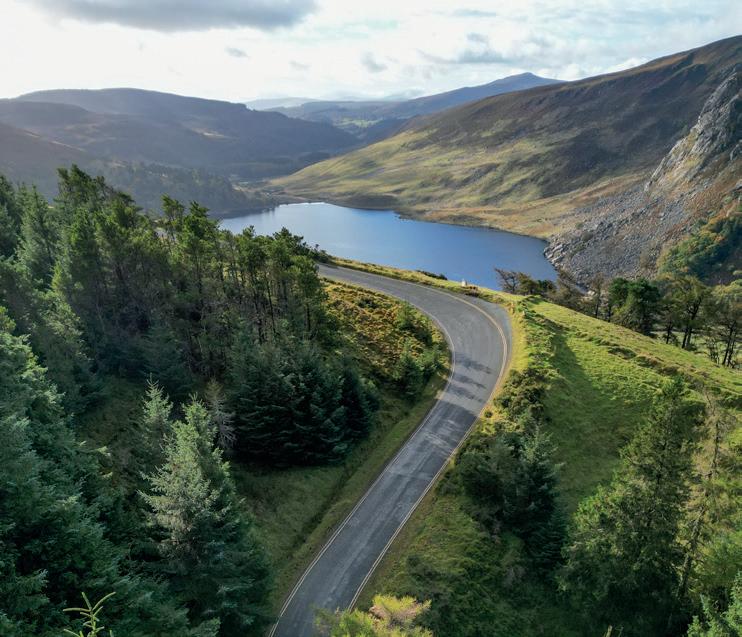
across South and Mid Wales, it’s chockfull of outstanding roads, rolling hills, open moorland, mountains and cascading waterfalls. The Black Mountain Pass (A4069) is a fantastic stretch of tarmac and one of the UK’s best riding roads. If you’re up for making a day of it, we recommend riding a loop from Brecon to Beulah, Llandovery, Trecastle, Brynamman, Penderyn and back to Brecon that should take around three hours, or longer if you want to stop and admire the stunning scenery.


Scotland’s vast wildernesses and incredible landscapes are a dream destination for motorcyclists.
Cairngorms National Park, the UK’s largest, offers truly epic riding experiences. Located in the Scottish Highlands, its high mountains, vast moorlands and shimmering lochs provide a sense of scale and remoteness. The SnowRoads is a 90-mile scenic route from Blairgowrie, south of the Cairngorms National Park, to Grantown-on-Spey in the Highlands. This ride boasts gorgeous views, while the quiet roads within the park offer opportunities for wildlife spotting and a true escape into nature.
Further north and west, the natural beauty and riding opportunities of the North Coast 500 (NC500) shouldn’t be missed. It’s a route suited for a multiday adventure but focus on sections that pass through areas such as the Assynt
“Cairngorms National Park, the UK’s largest, offers truly epic riding experiences”

National Scenic Area. The single-track roads with passing places require care but reward the rider with stunning views of remote beaches, striking sea stacks and craggy mountains.
Visit Backwater Reservoir Viewpoint near Blairgowrie to earn 25 points.
For more information on the 2025 Club Challenge, read our guide on page 54.
Riding through national parks is an enriching experience that combines great roads with serene landscapes, but it’s important to remember that they’re protected areas with strict speed limits to ensure the safety of visitors and wildlife. It’s vital to be a good ambassador for responsible riding.
You’ll be sharing the roads with other recreational users, so keep your speed down and leave plenty of space for walkers, horses and cyclists. On narrow back roads or green roads, be prepared to stop and even switch off your engine when sharing the road with ridden horses.
Don’t ride on bridleways and footpaths, and if you have a dualpurpose bike, only go off-road in designated areas.
Maintain the integrity of these protected areas by ensuring you leave nothing behind. Also, be mindful of excess noise – ride quietly and unobtrusively, especially in quieter areas.
The Trail Riders Fellowship (TRF) provides a code of conduct for responsible riding in the countryside. For more information, visit: trail.trf.org.uk/conservation/code-ofconduct/




A discreet GPS/ RF tracker that monitors the movements of any motorcycle, moped or scooter in real time, allowing you to view status and journey history 24/7, with notifications for unauthorised movements, low battery voltage, bike over alerts and more. BikeTrac is insurance approved and offers advanced live monitoring for your pride and joy.



It’s vital that our team and dealer networks are up to date with the latest information on our range of products, which requires regular training. Our UK Technical Trainer, Carl Lillywhite, is the man responsible for creating and managing those training sessions, and we caught up with Carl to find out what that involves
Hi Carl, thanks for your time! Could you tell us a little more about your role at Kawasaki?
So, my role is to basically manage training for our dealers and wider Kawasaki team for motorcycles and the ATV range. That means designing and running courses that cover everything from new models to tech

updates, as well as courses on suspension, electronics and everything else in between. I also manage the IMI (Institute of the Motor Industry) accreditation for our dealer network.
did you get
I’ve always been into motorcycling and used to race motocross and enduro in the British Championships. Before that, I was a race team mechanic for my brother. As for my two-wheel career, I worked in motorcycle maintenance for 15 years before getting a role at Kawasaki Motors Europe for several years.
After that, I moved on to another company for a while and then came back to Team Green with this role at Kawasaki UK.

If you could go on a biking holiday, where would you go?
I’ve been lucky enough to go on a few biking holidays already, including a great trip through Europe, but I think my dream would be to take a road bike and ride over to watch the Red Bull Romaniacs event in Sibiu, Romania.

I think that for everyday use, I’d go for the new Versys 1100. For riding with mates, I’d have a Ninja 1100SX and then any of the current off-road bikes. I would also love a classic Kawasaki in there, like the 2-stroke KX250.
Getting to work in motorcycling is always great, but I particularly enjoy seeing everything come together and people working through the courses I’ve designed and created. I also really like being able to add value to the brand through these courses, ensuring our customers are getting the best experience possible.


Finally, what do you like to get up to when you’re not working?
Sadly not as much riding as I used to, but I like keeping fit and am regularly out on my mountain bike. I also enjoy working on my classic tractor, which is a bit random, I know!
All members are invited to join the Club Challenge! This is a great opportunity to visit new places, meet fellow Club members and earn points for the chance to win prizes at the same time. Read on for details of the locations and how you can win the top prize of a BikeTrac unit.
The 2025 Challenge is open from 1st February 2025 to 12th December 2025.
1 Visit the locations listed.
2 Snap your Challenge Selfie.
3 Submit your Challenge Selfie using the upload tool (one submission per location).
4 We will add your points to the Challenge Leaderboard and photo to the gallery.
5 Repeat steps 1-3 as many times as you can before the closing date!
n We will announce the winners in December 2025.
1 Visit www.club-kawasaki.co.uk/ challenge-selfie-upload
2 Go to the ‘Selfie upload tool’, choose your location from the list and add your photo.
3 We’ll receive a notification to say you’ve submitted a photo for the Challenge and we’ll approve it – as long as we can see it includes the location listed.
4 Your photo and points will then appear on the gallery and leaderboard.
Standard locations are worth 25 points. Hero locations are worth 50 points. Kawasaki dealer locations are worth 20 points.
Kawasaki UK events are worth 30 points NEW Win double points if you take a selfie with another Club member at a location! Simply include their username when you submit your photo.
The 2025 Challenge is open from 1st February 2025 to 12th December 2025
Receive an exclusive £1500 of FREE Helmet & Protective Clothing cover worth £29.99 when you purchase an annual motorcycle insurance policy. As a Club member, you could also receive a 25% discount, so make sure you have your membership number ready and call Kawasaki Insurance on 0800 085 6551 to claim the offer. T&Cs apply.
BIKETRAC UNIT RRP £299
Visit the most Hero locations to be in with a chance of winning a discreet GPS/RF tracker that monitors the movements of your bike in real time, allowing you to view status and journey history 24/7 with notifications of unauthorised movements. It also offers a theft response service, bike over-alerts and more. Insurance approved. Theft protection for your pride and joy from BikeTrac.
KAWASAKI INSURANCE POLICY
RRP £250
Gain the most points overall to be in with a chance of winning a free Kawasaki insurance policy up to the value of £250, including free helmet and leathers cover. If more than one person has the same top score, a winner will be chosen at random.
TWO WEEKEND PASSES TO BSB
RRP £200
Visit the most events throughout the year to be in with a chance of winning two weekend passes to a BSB race of your choice.
SILKOLENE BUNDLE RRP £106
Visiting any of ficial Kawasaki dealership across the UK will gain you points towards winning a Silkolene bundle, including a Pro Chain Aerosol, Pro Prep, Brake & Chain Cleaner, Wash Off and Silkolene T-shirt, hoodie and cap.
RAC RENEWAL RRP £90
Visit all four locations within a region to be in with a chance of winning Kawasaki assist vehicle-based cover for a year. This includes roadside assistance, at home, recovery and onward travel. There will be one winner per region, so you have five chances to win this prize.
CLUB CLOTHING BUNDLE
RRP £59.95
Submit your best selfie for a chance to win a Club Cap and a Club Kawasaki Gilet. One person from each region will win this prize.

25 POINTS
“The Big O” is a striking corten steel sculpture standing at four metres high. It’s nestled in the scenic landscape of Camus, Connemara, County Galway.
50 POINTS
This beautiful avenue of beech trees was planted by the Stuart family in the 18th century. It was intended as a compelling landscape feature to impress visitors as they approached the entrance to their Georgian mansion, Gracehill House.
4 3 2 1
25 POINTS
25 POINTS
This secluded paradise offers golden sands, dramatic cliffs and breathtaking coastal views.
Burr Point is considered the easternmost point of mainland Ireland.



50 POINTS
Skye Bridge first opened in 1995 and connects the Isle of Skye to the mainland village of Kyle of Lochalsh.
50 POINTS
Wensleydale Creamery, located in the market town of Hawes, North Yorkshire, makes several varieties of cheese, including the famous Yorkshire Wensleydale.

Wensleydale Creamery
25 POINTS
Built in 1818, this stone lighthouse stands at the end of Port Logan Pier.

25 POINTS
The reservoir in Angus supplies drinking water to Angus, Dundee and parts of Perth and Kinross.

25 POINTS
Monument to Charles Marjoribanks, MP for Berwickshire. Created in 1834.

25 POINTS
This National Trust café and visitor centre sits on the slipway to the beach in Robin Hood’s Bay.

Old coastguard station
25 POINTS
A tribute to engineering genius Isambard Kingdom Brunel on the waterfront in Saltash, Cornwall.
25 POINTS
Westonbirt Arboretum near Tetbury, Gloucestershire, is a world-renowned tree collection with more than 15,000 trees and shrubs from around the world.

ALICE
STATUE 25 POINTS
The sculpture of Alice Nutter in the village of Roughlee was designed and built by local artist David Palmer.
25 POINTS
Highly recommended by other riders for its incredible roads and stunning scenery.
13 THE MERRY
STONE CIRCLE 50 POINTS
The Cornwall site dates from the late Neolithic-early Bronze Age and consists of a circle of 19 stones.
25 POINTS
Originally stood at the southern end of London Bridge as a memorial to the Duke of Wellington but moved to Swanage, Dorset, in 1868.
Check out the full details of all locations, see the photos submitted so far and find out who’s working their way up the leaderboard by visiting www.club-kawasaki.




Ness
Situated in the South Downs among some of the best biking roads in England, this café is run by bikers for bikers –although everyone is welcome!
25 POINTS
This 20-acre garden in King’s Lynne, Norfolk, is home to more than 200 rose varieties, an array of ancient trees and a walled garden holding an orchard of rare local apple varieties.






















